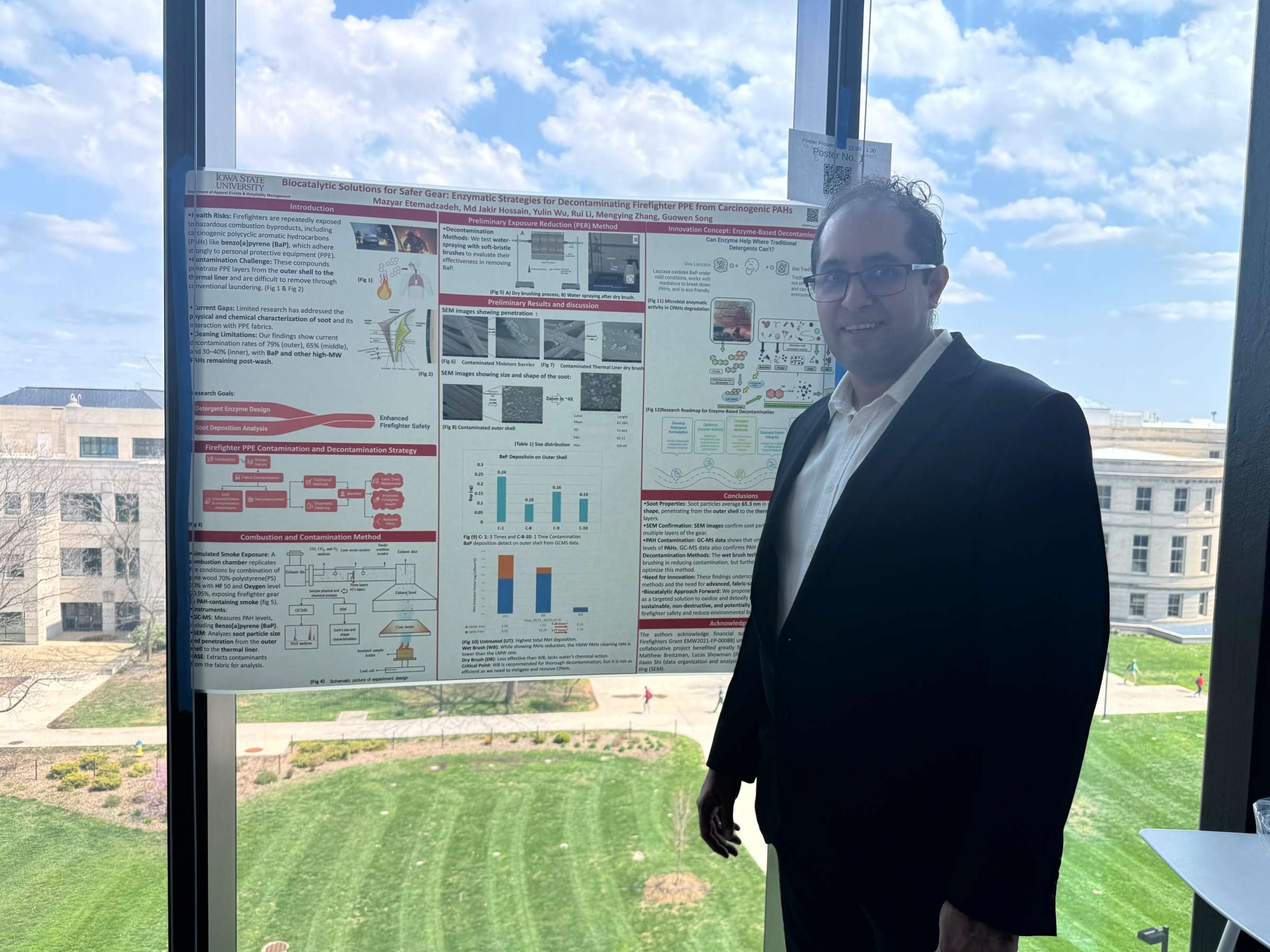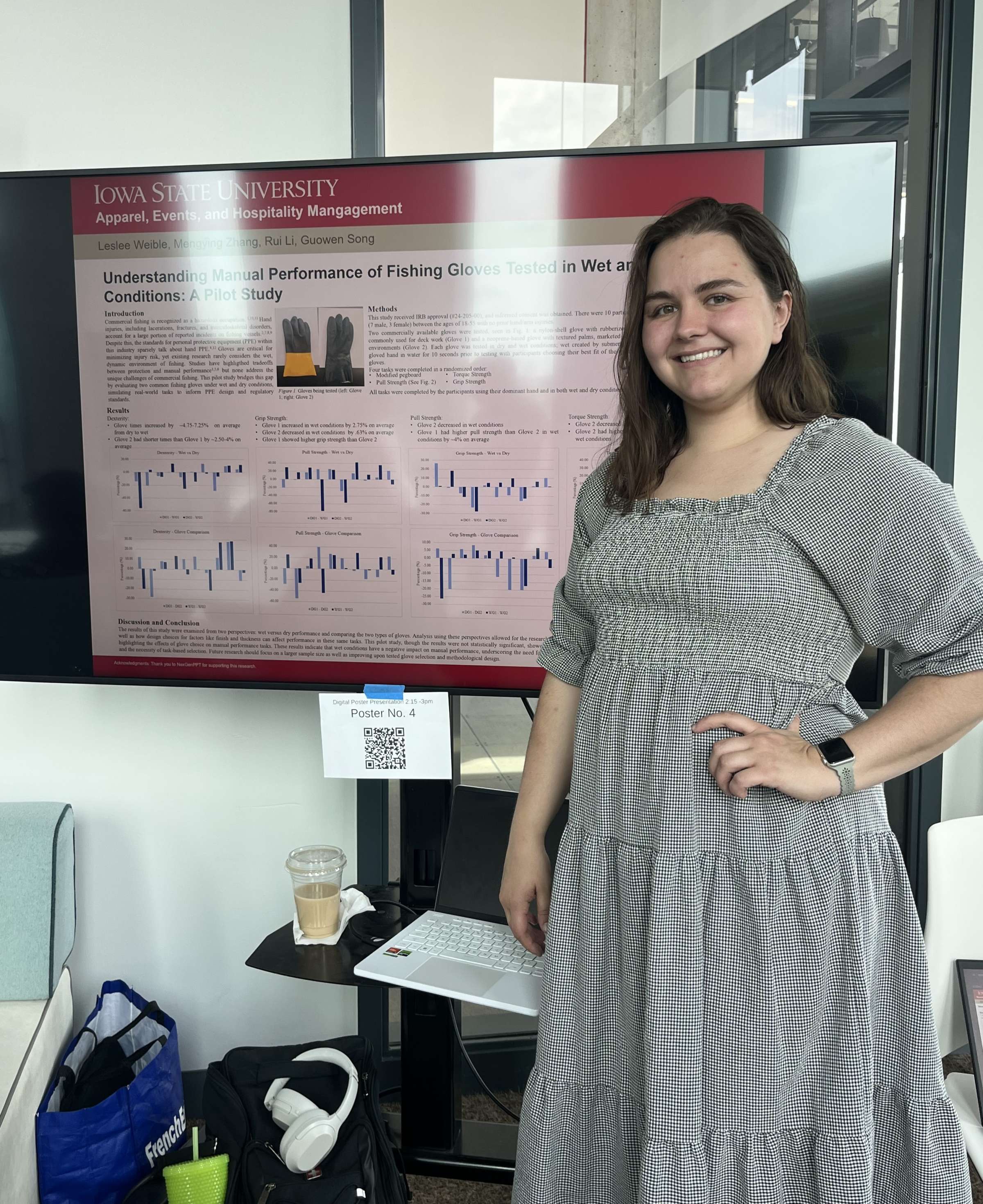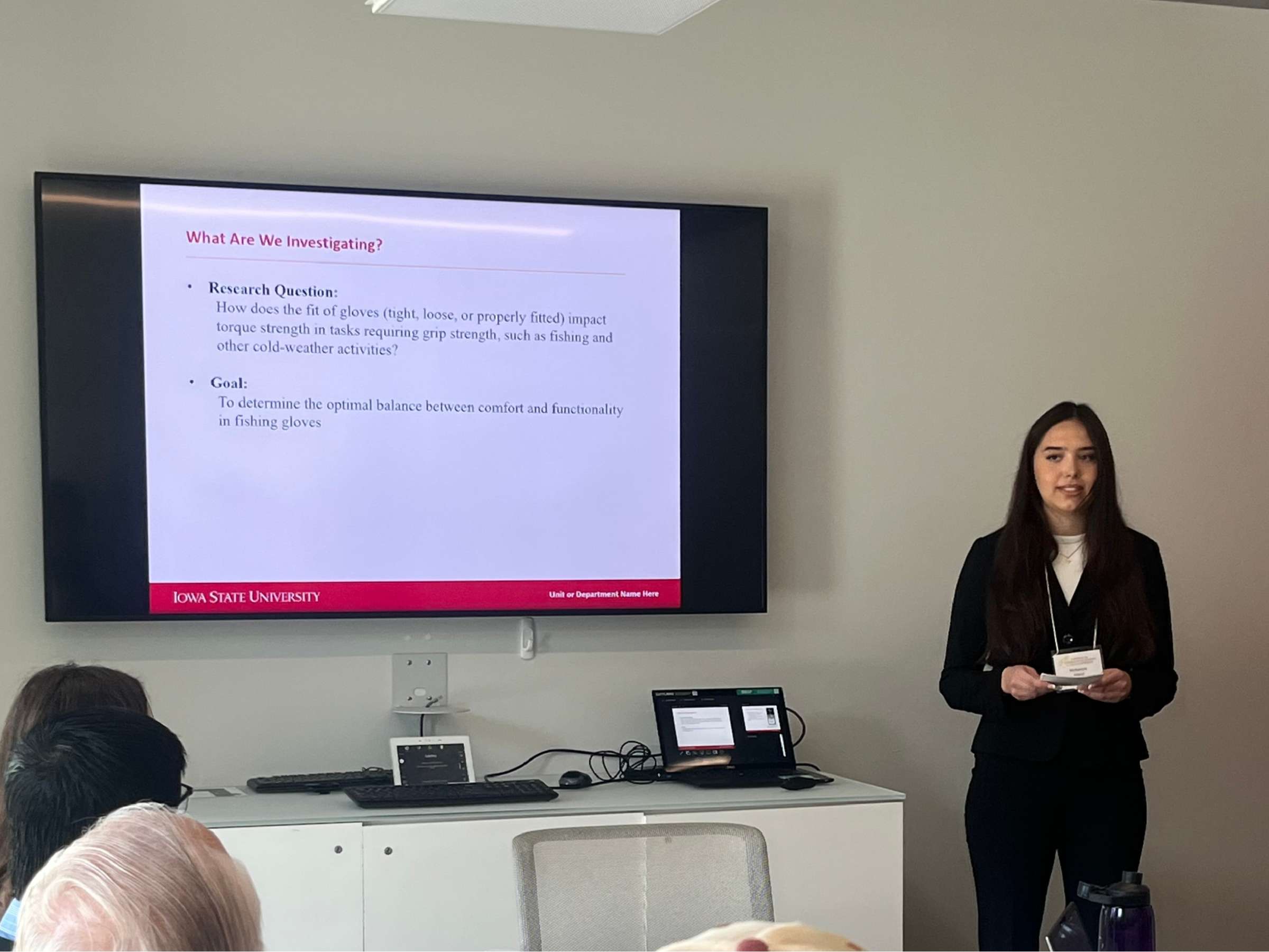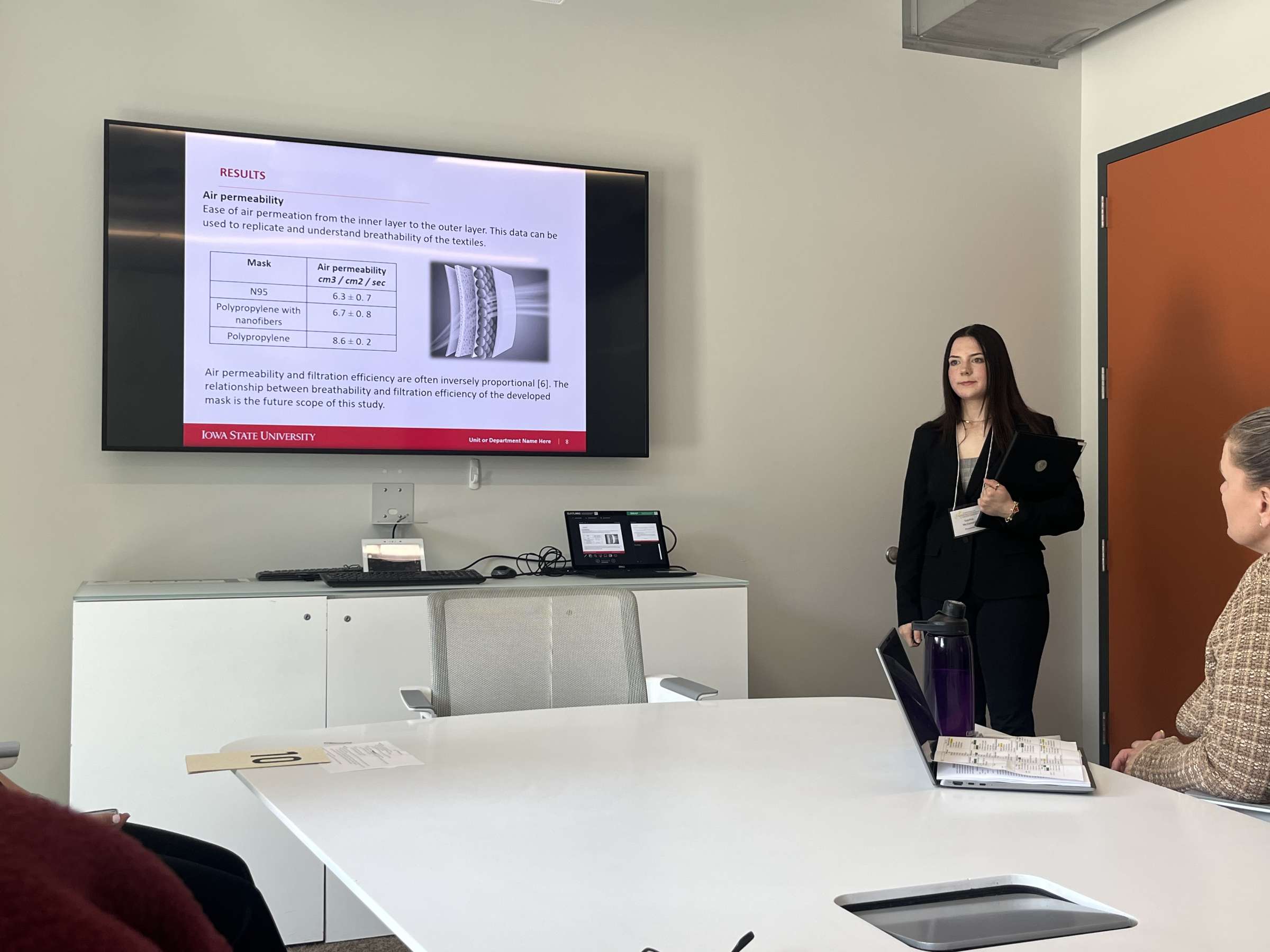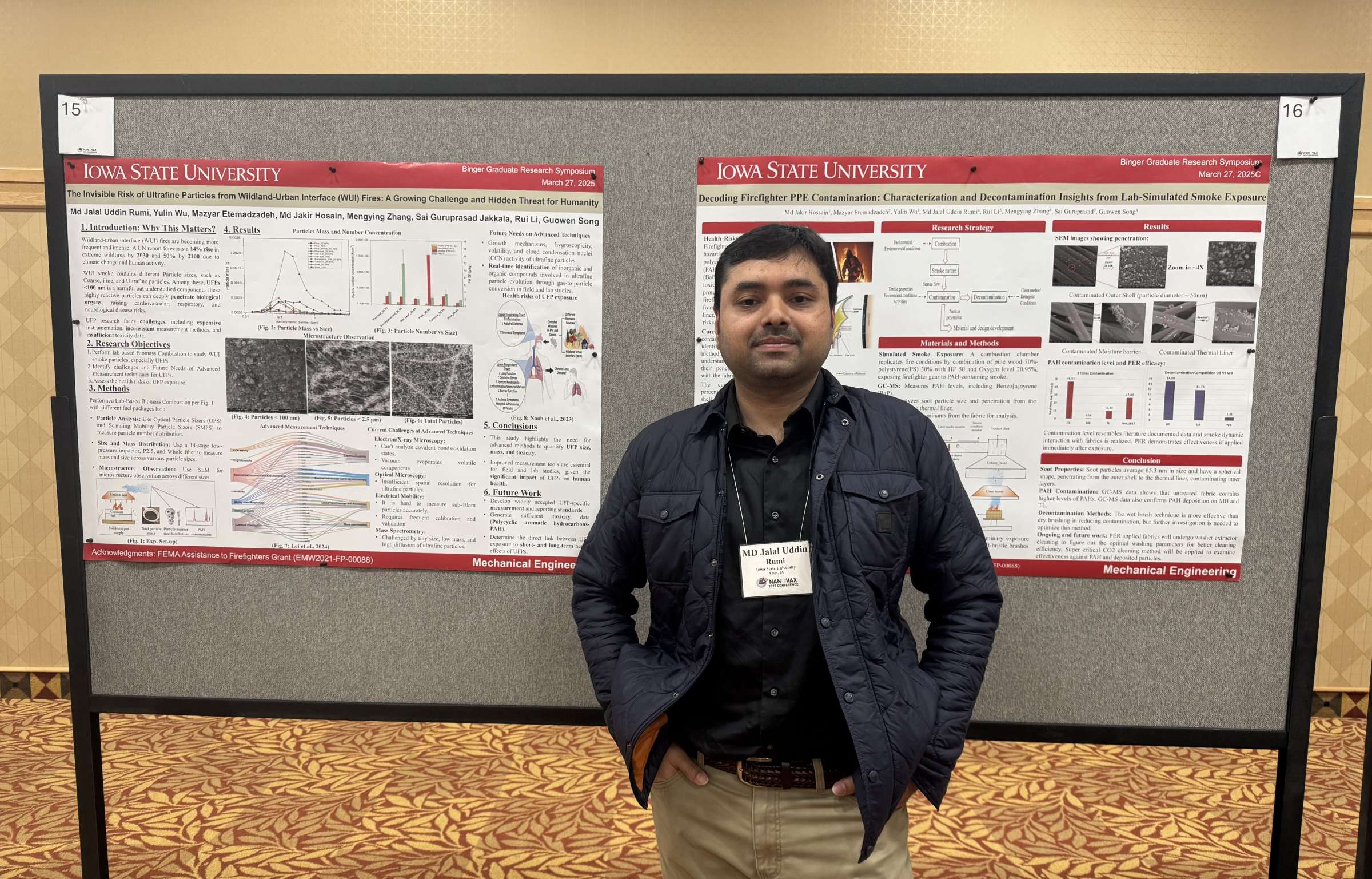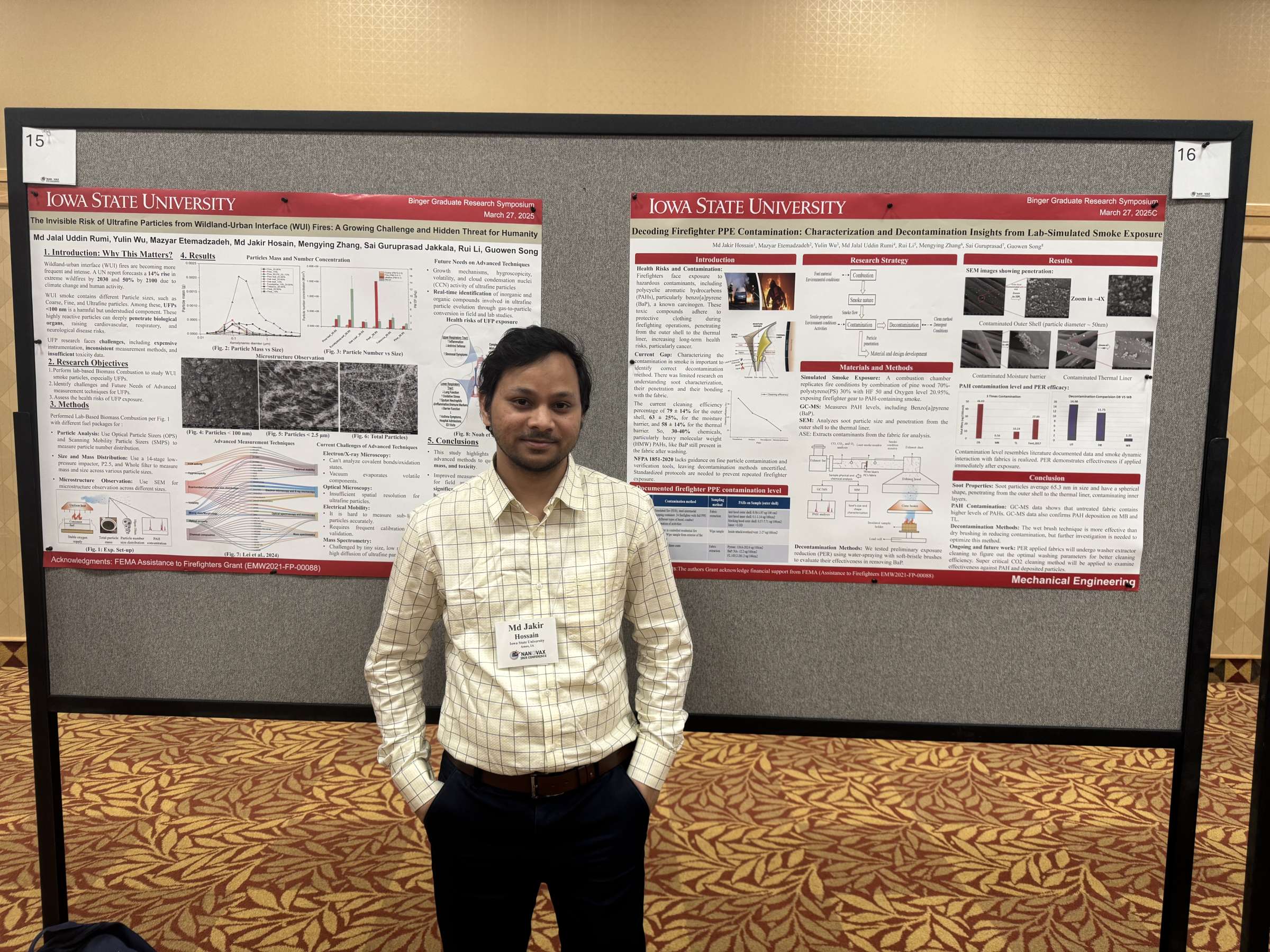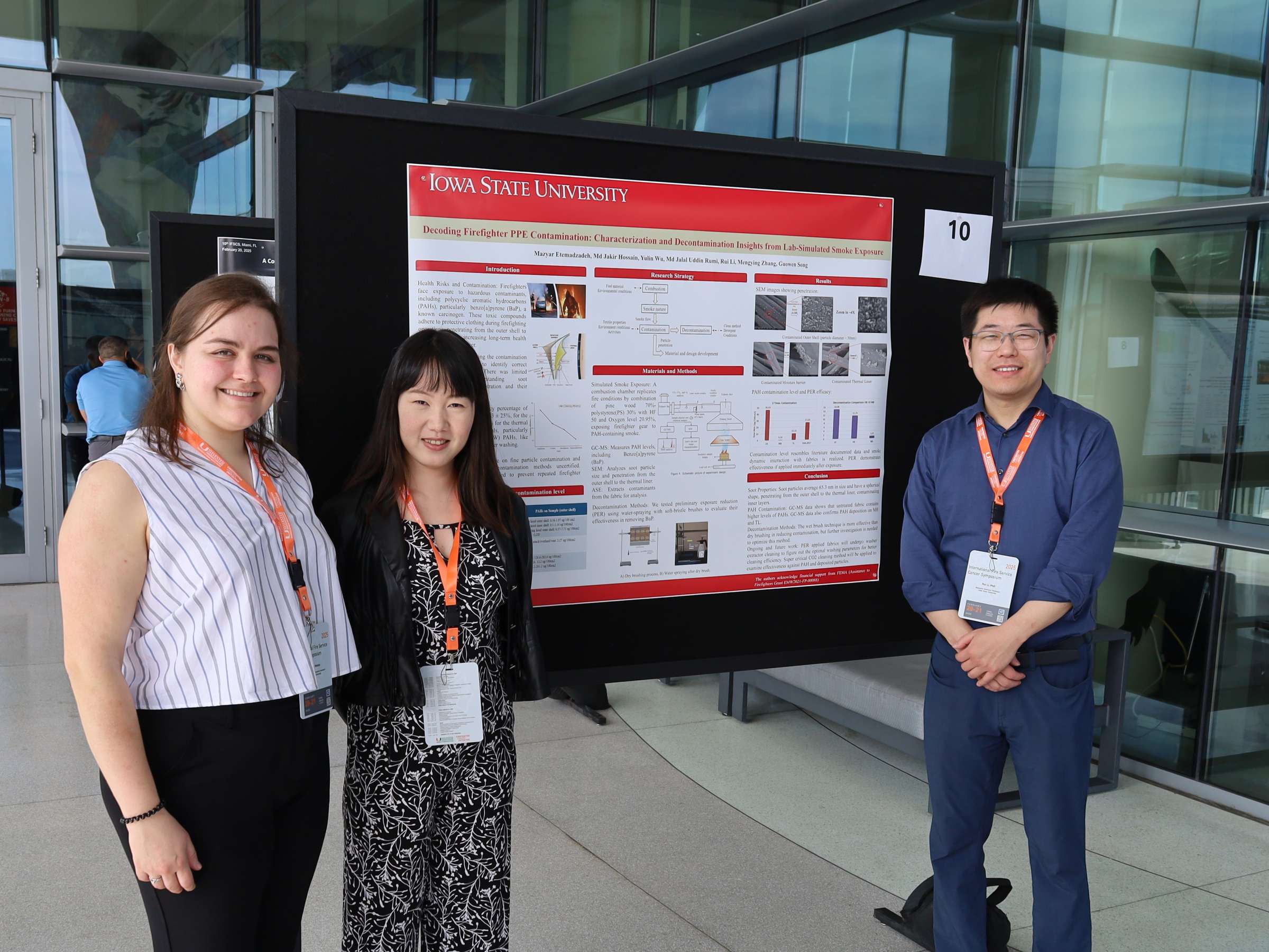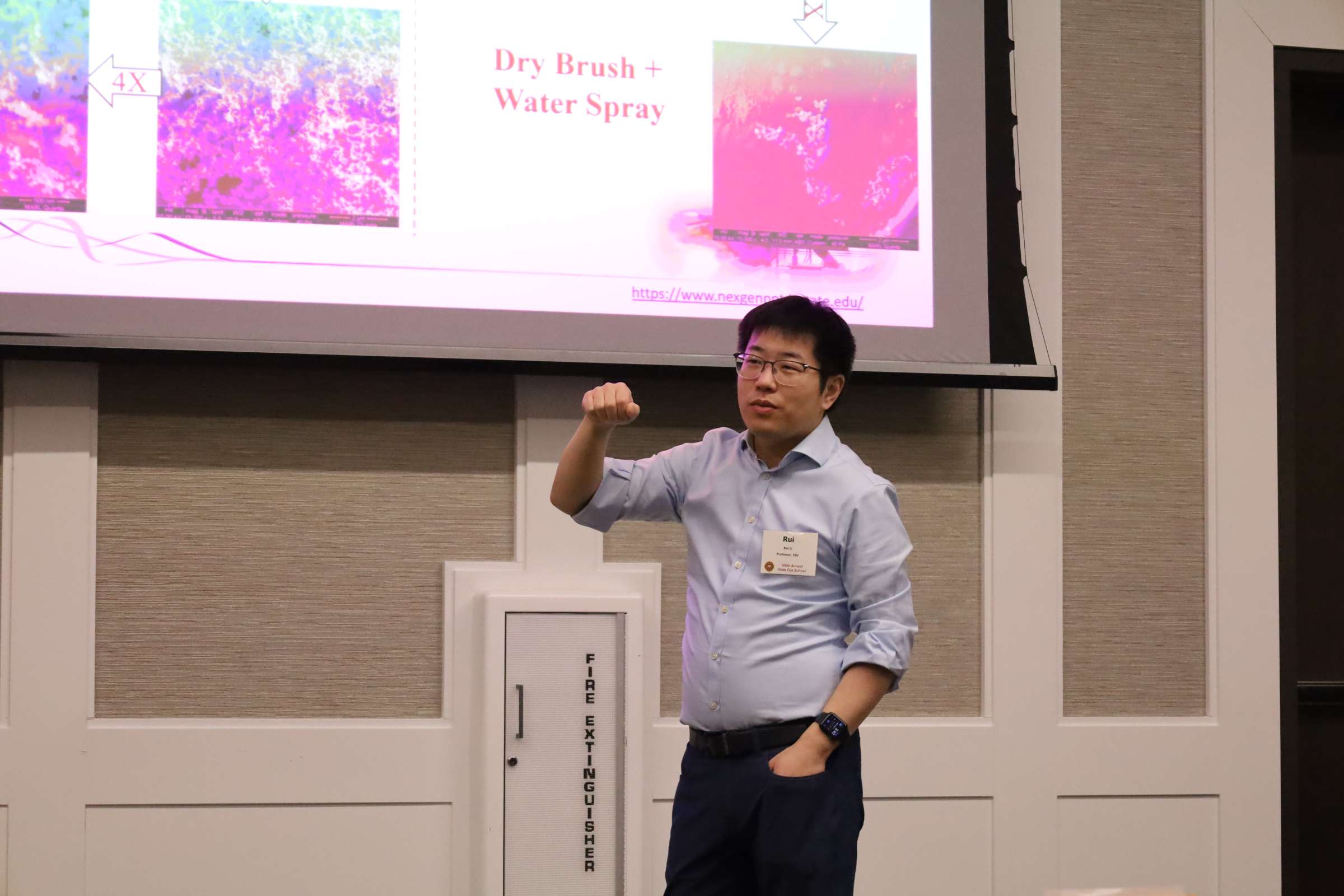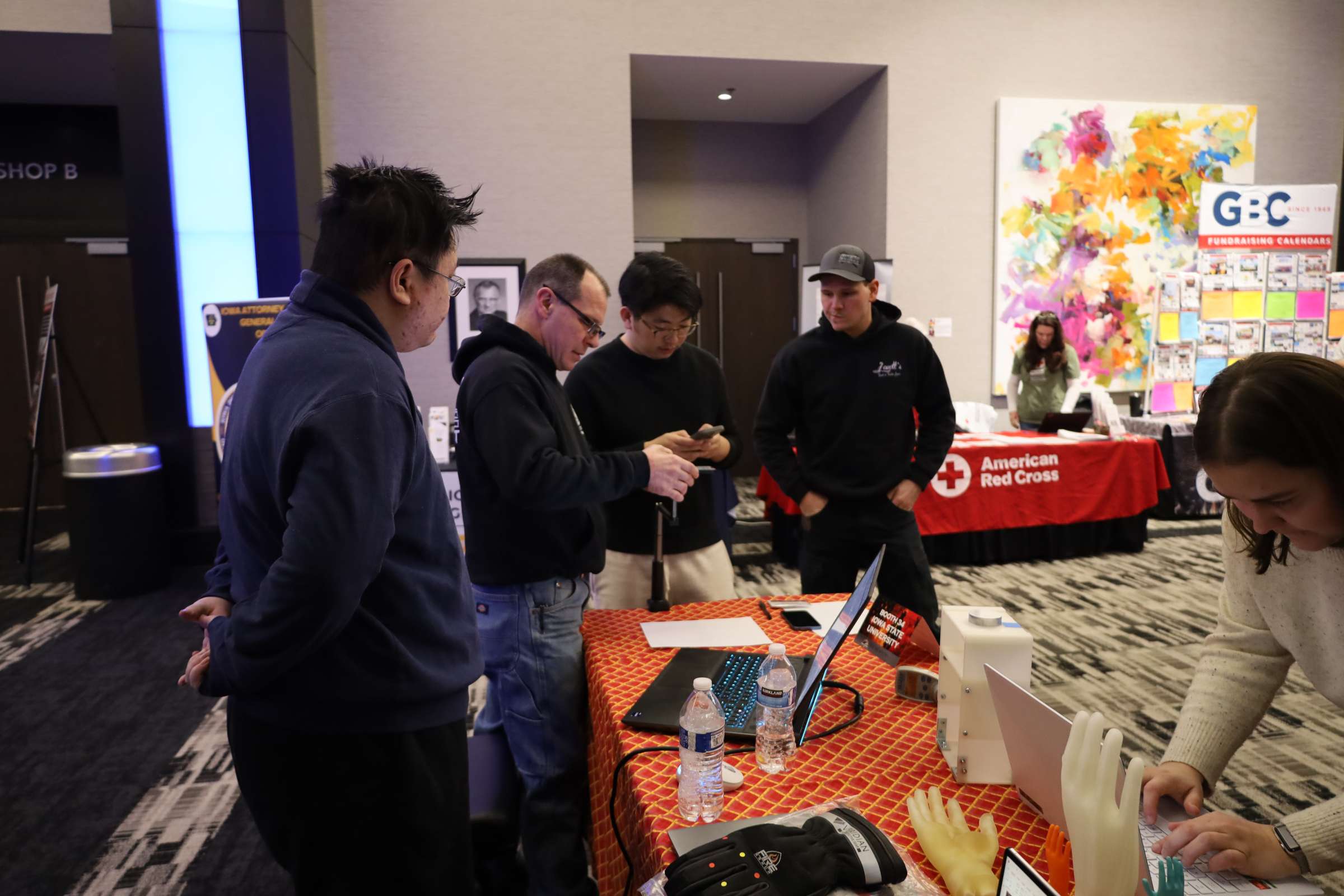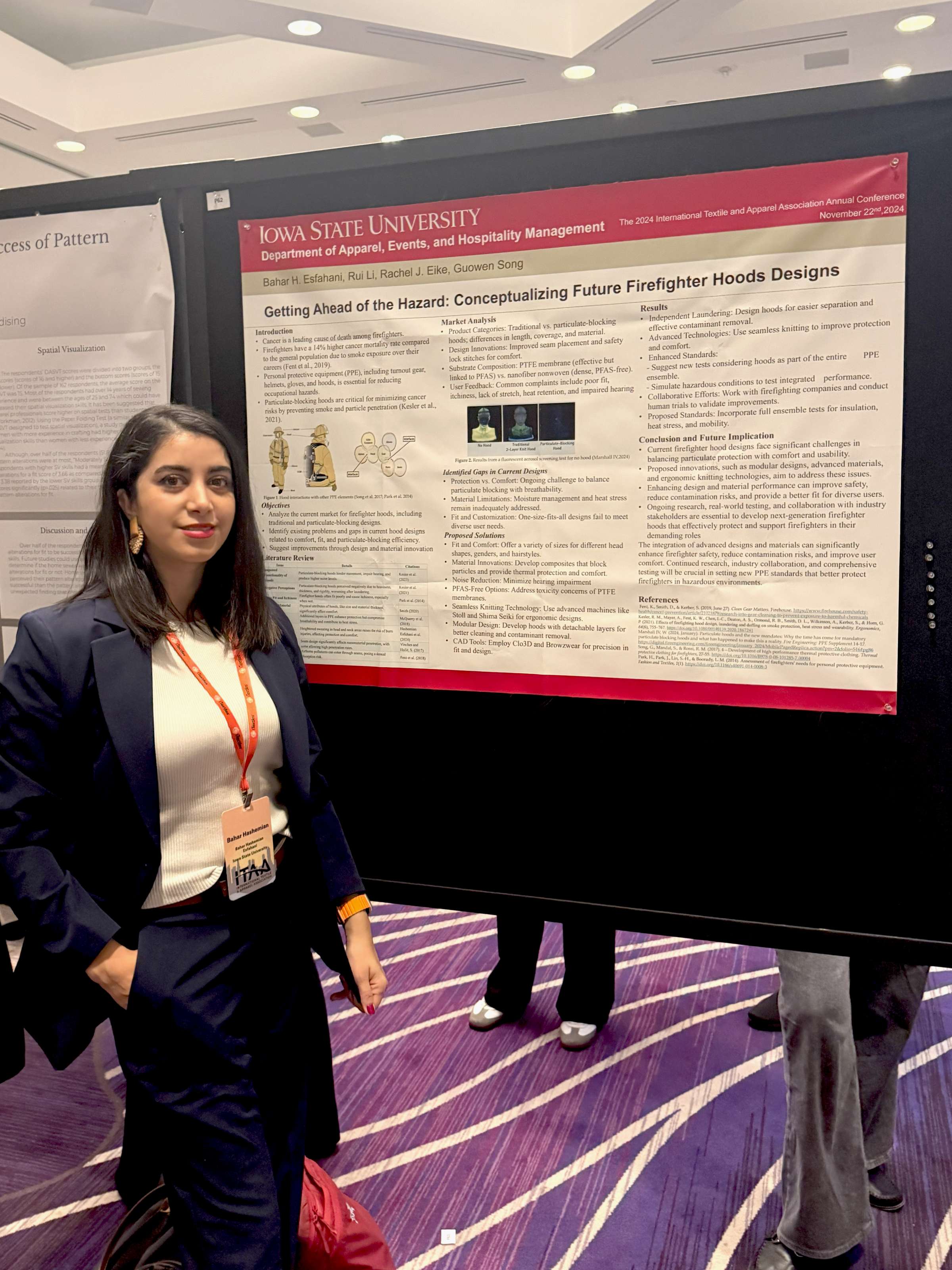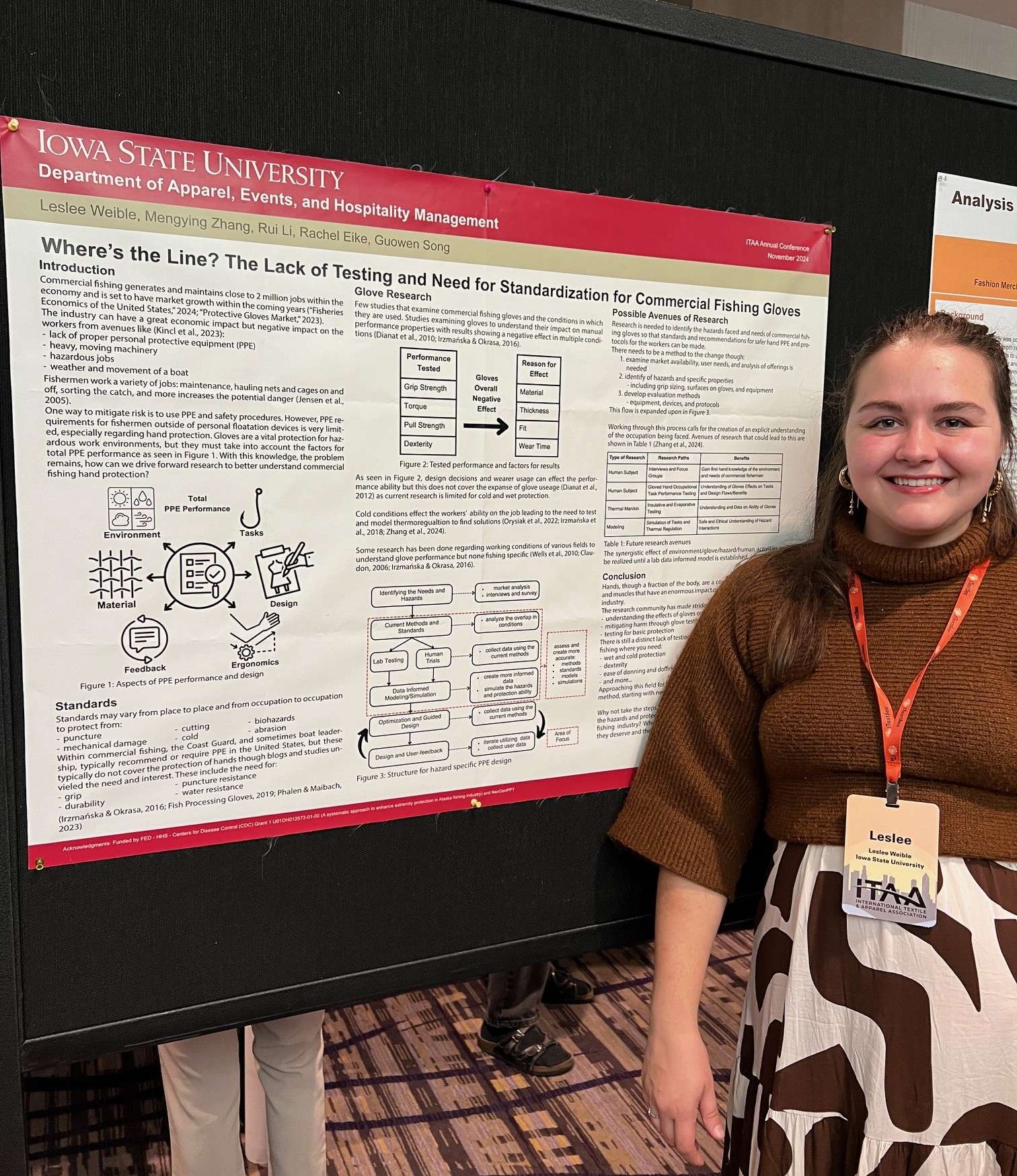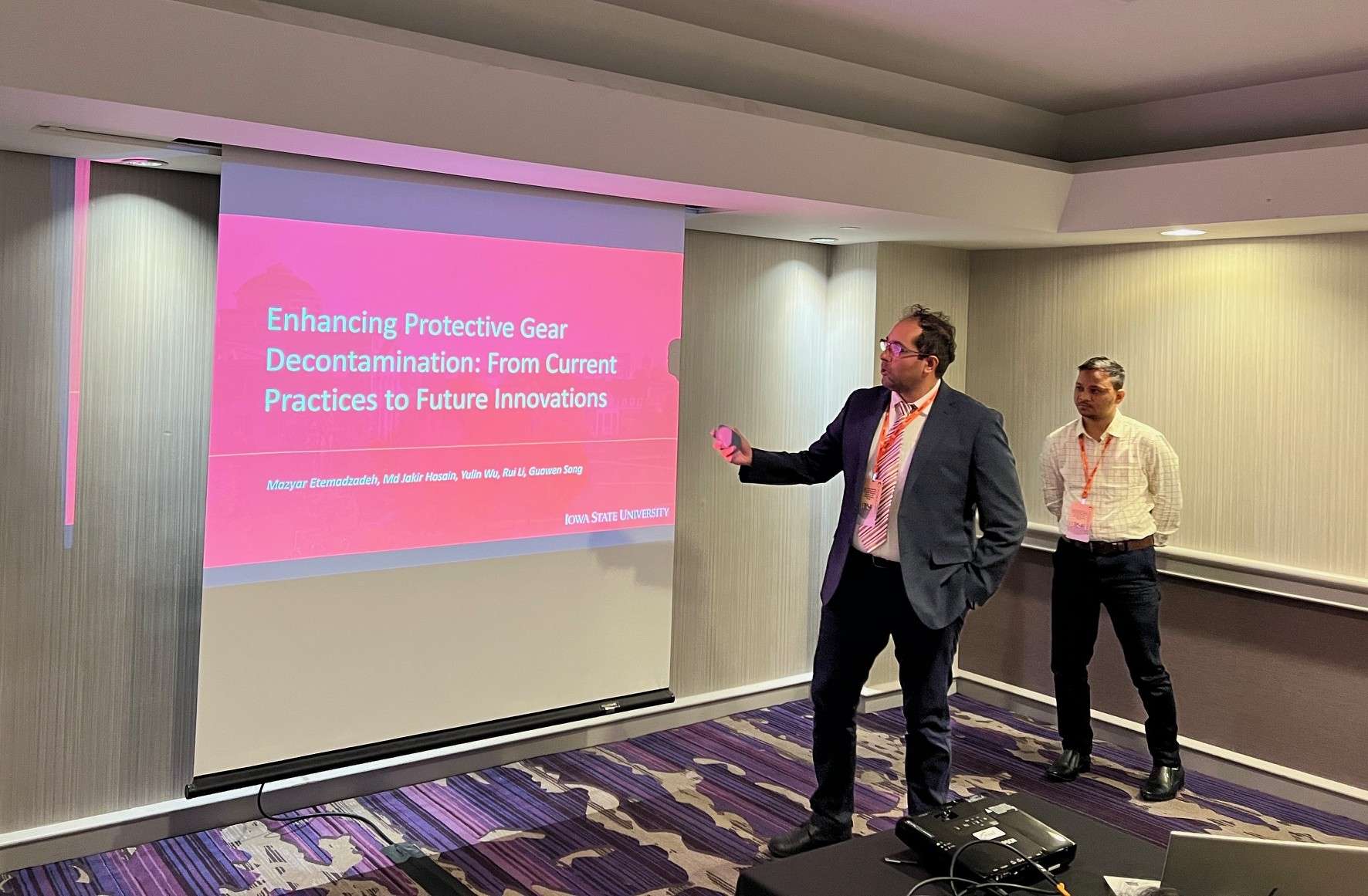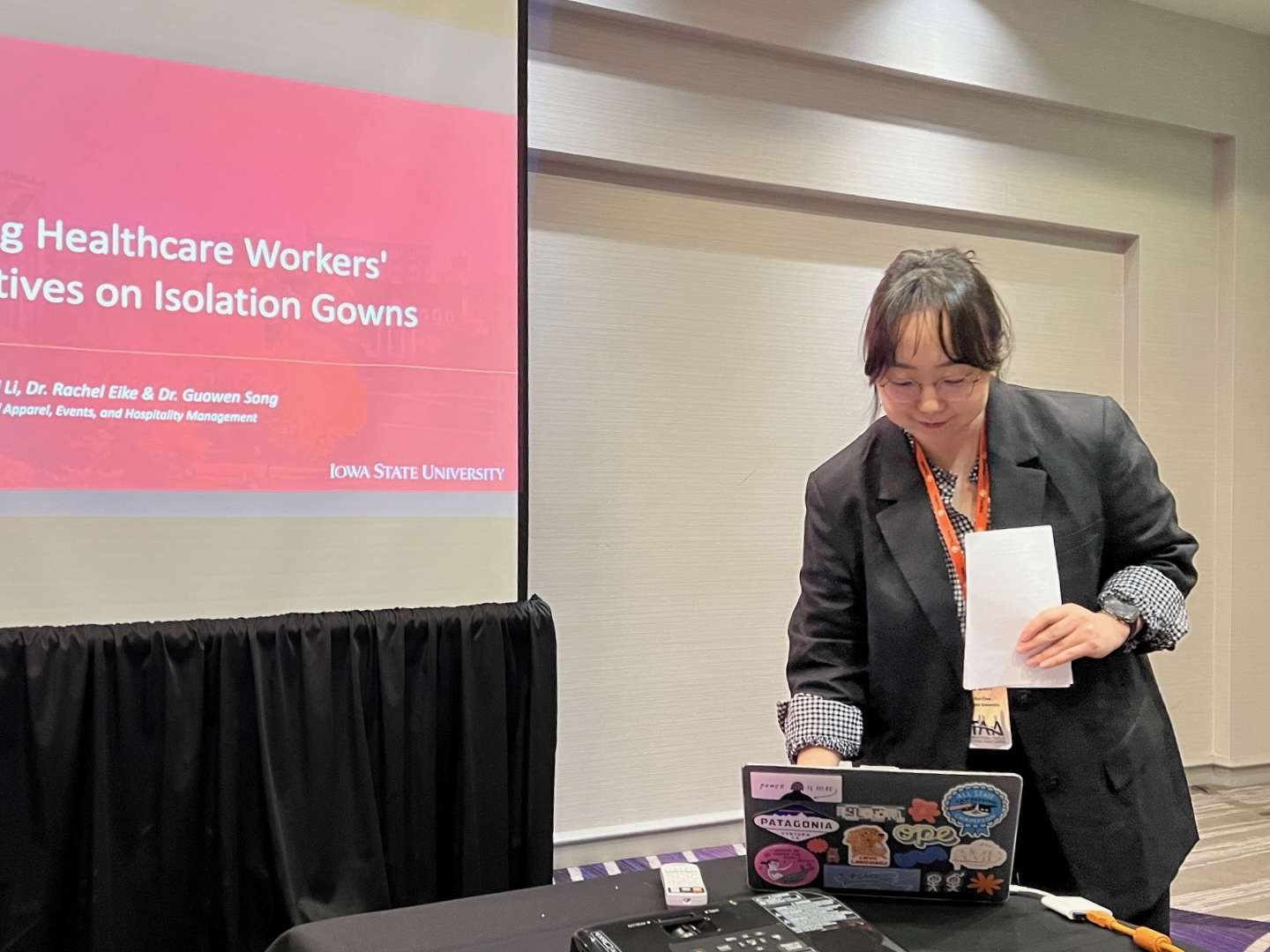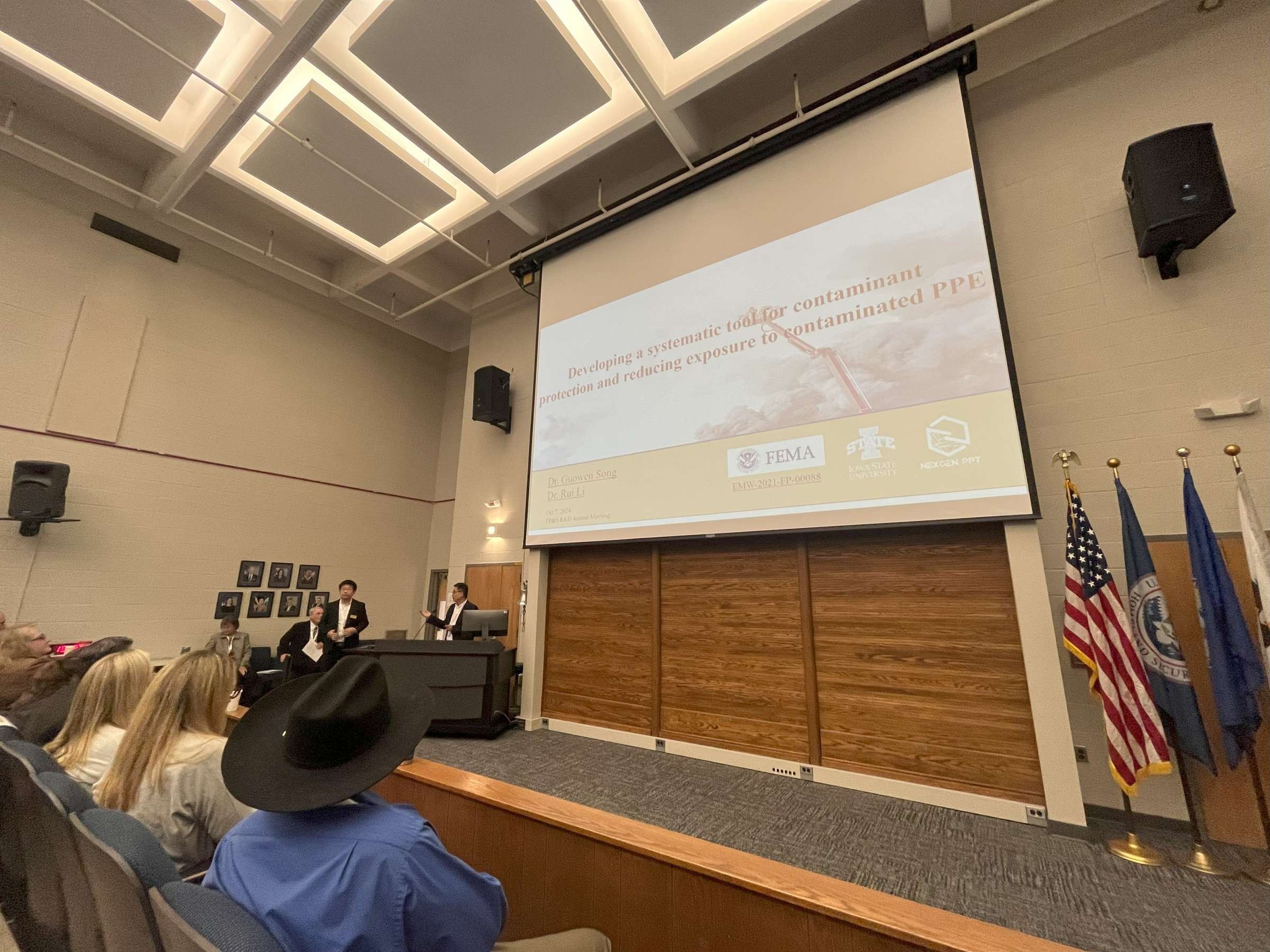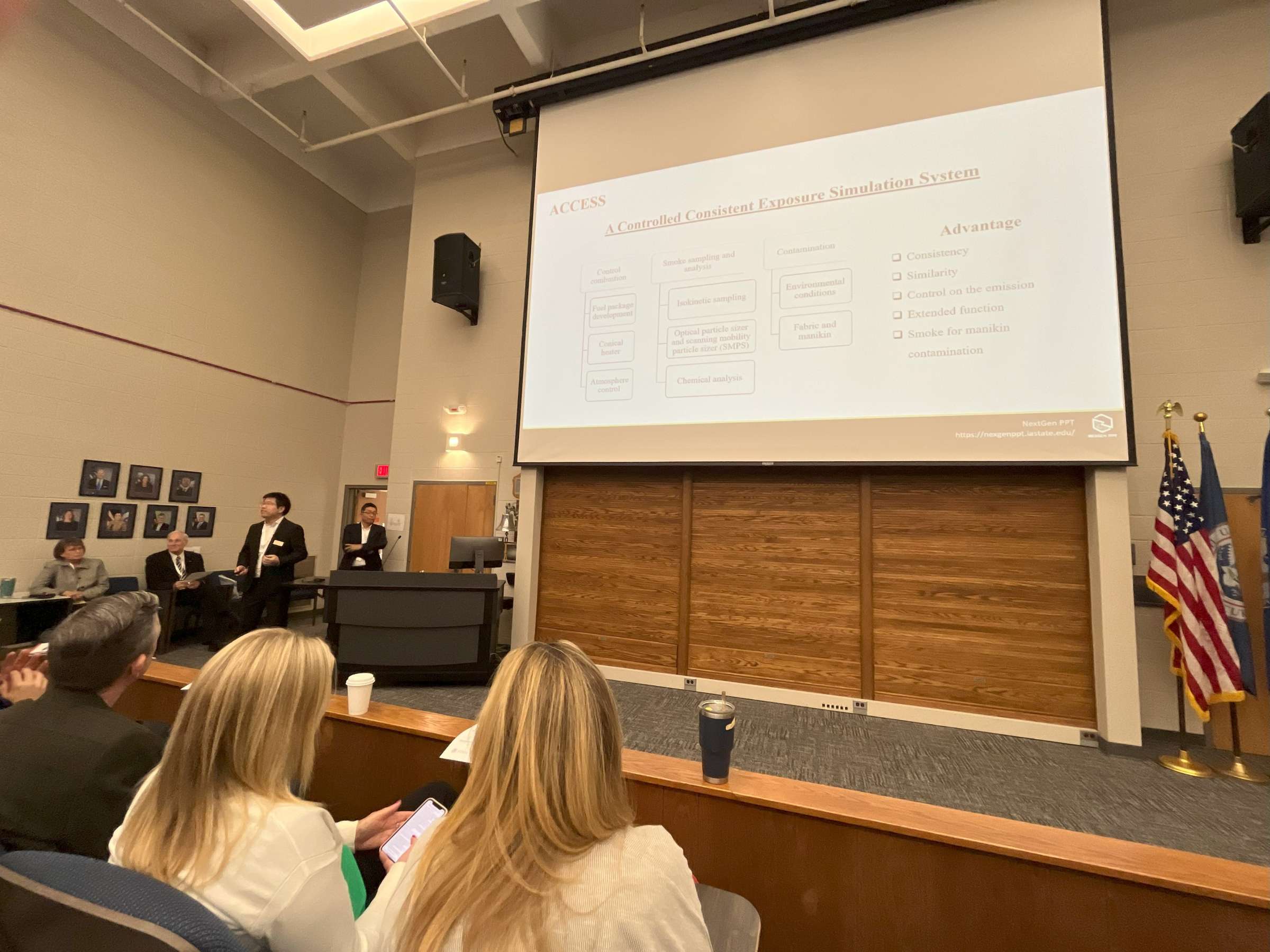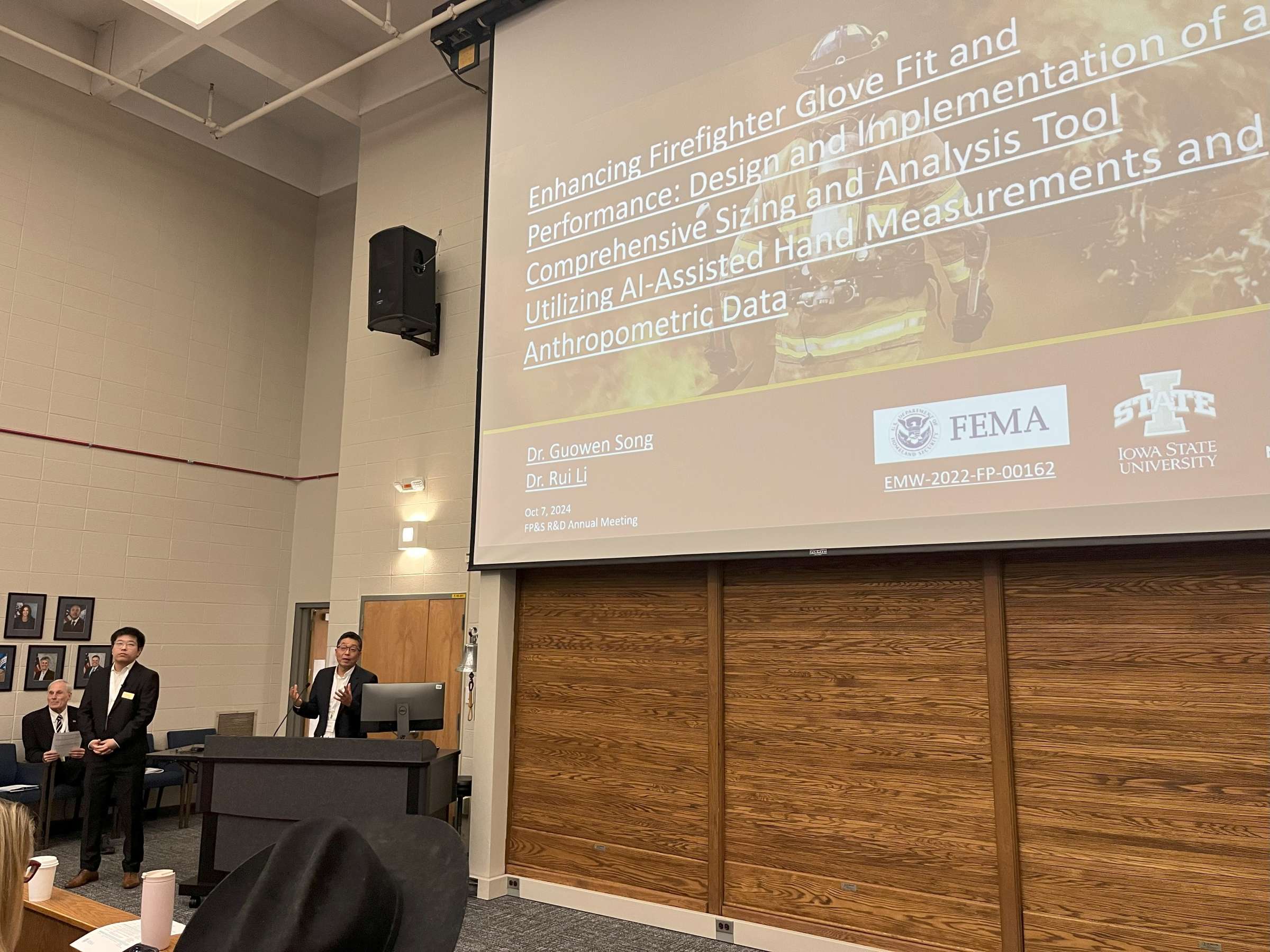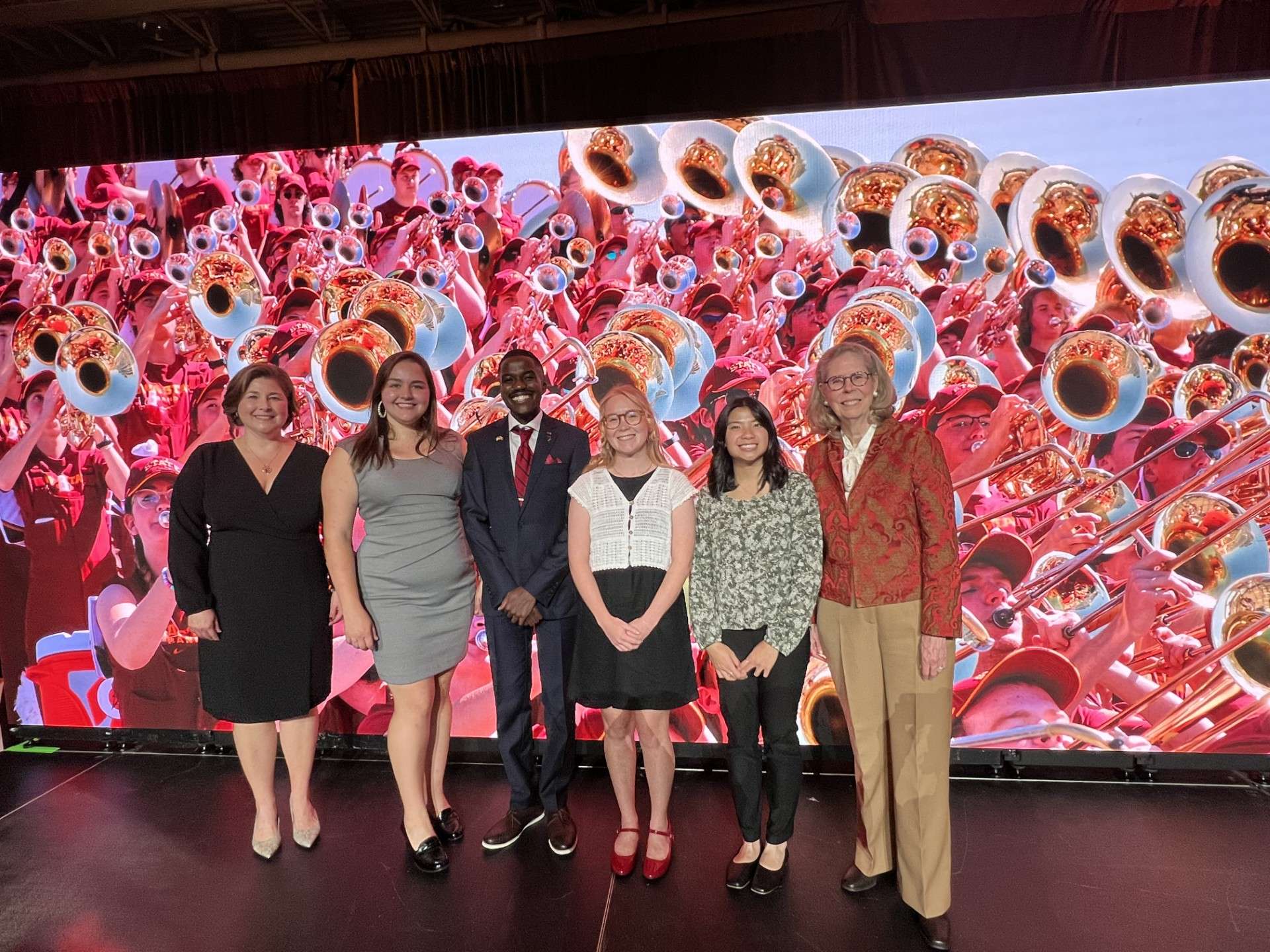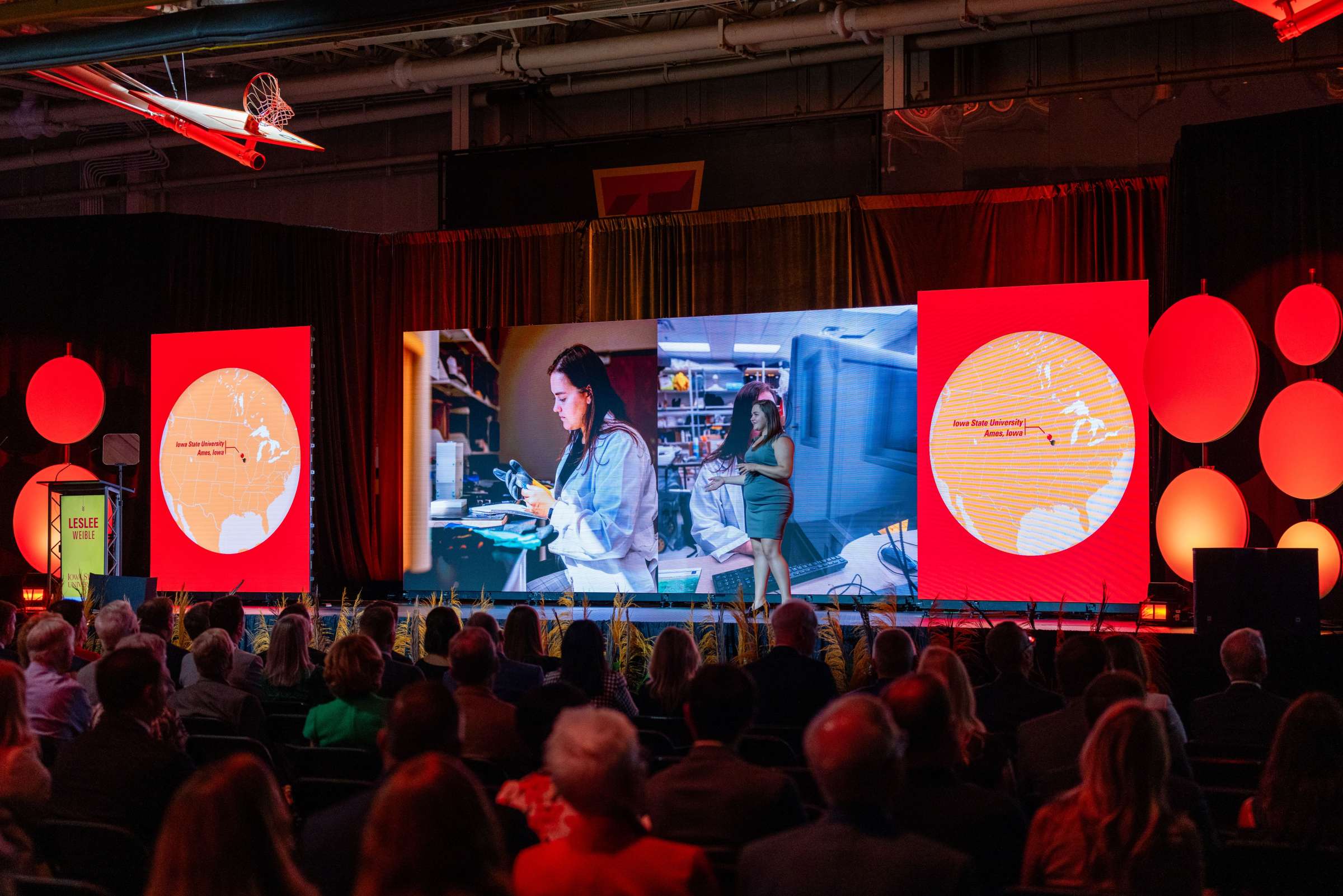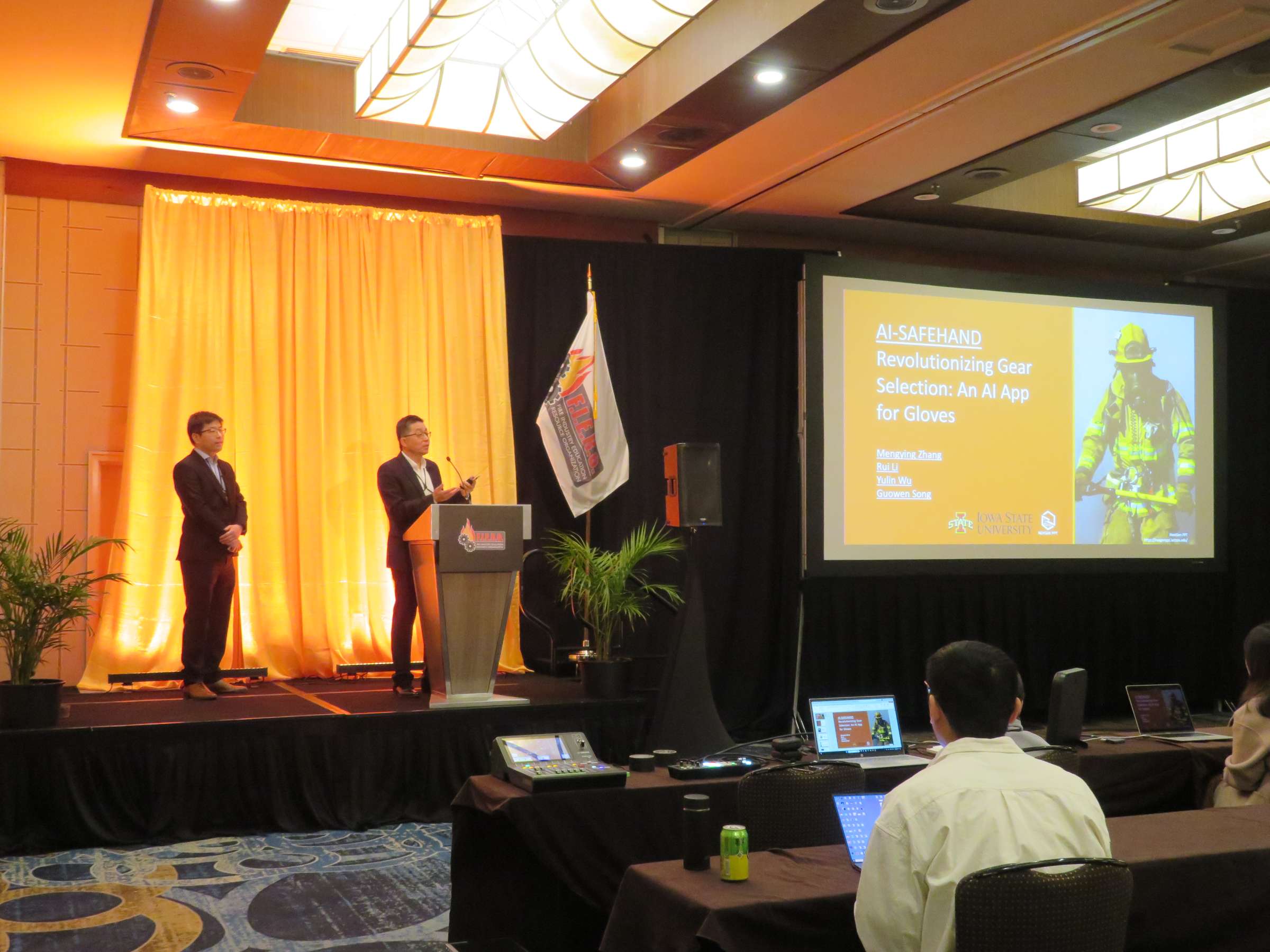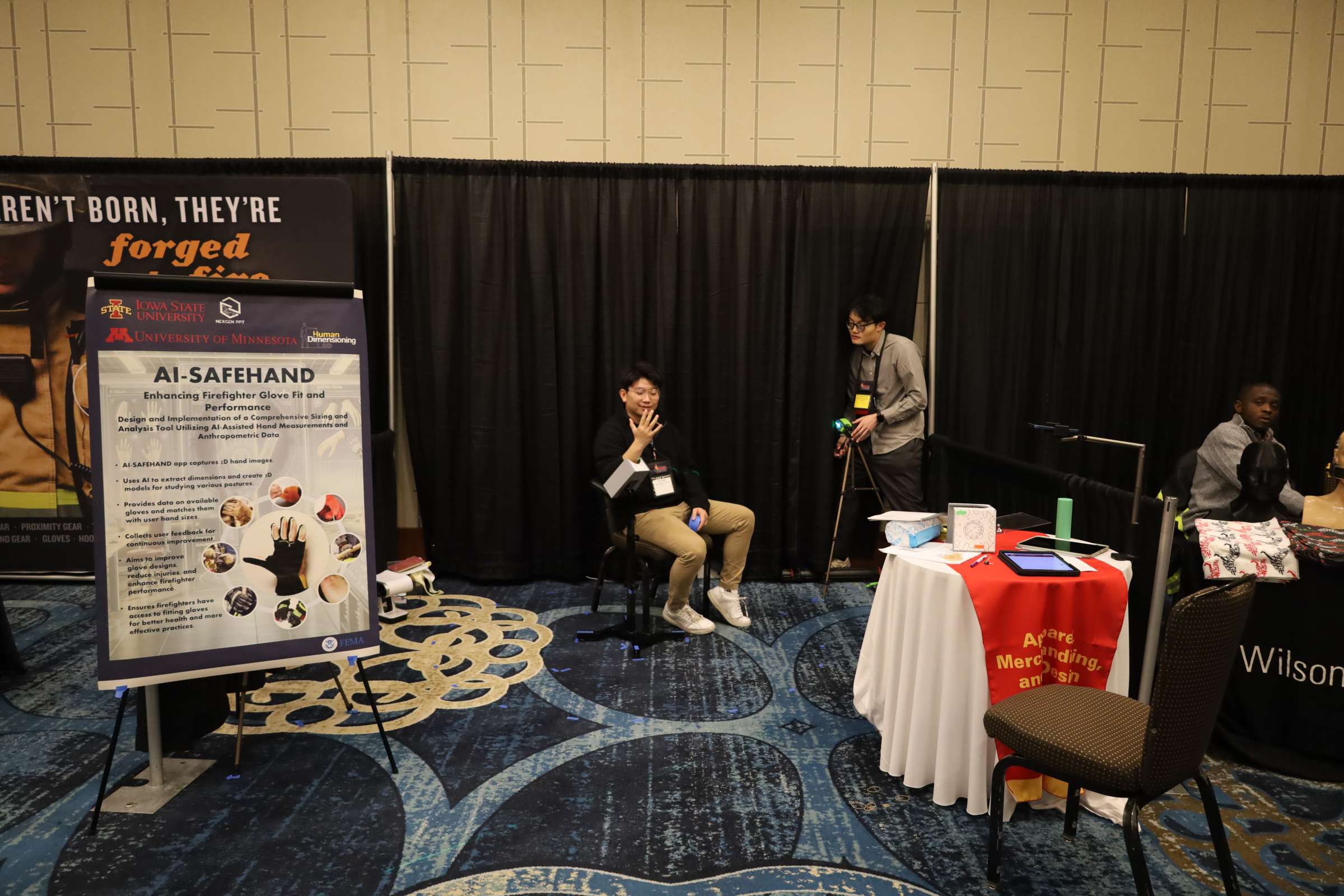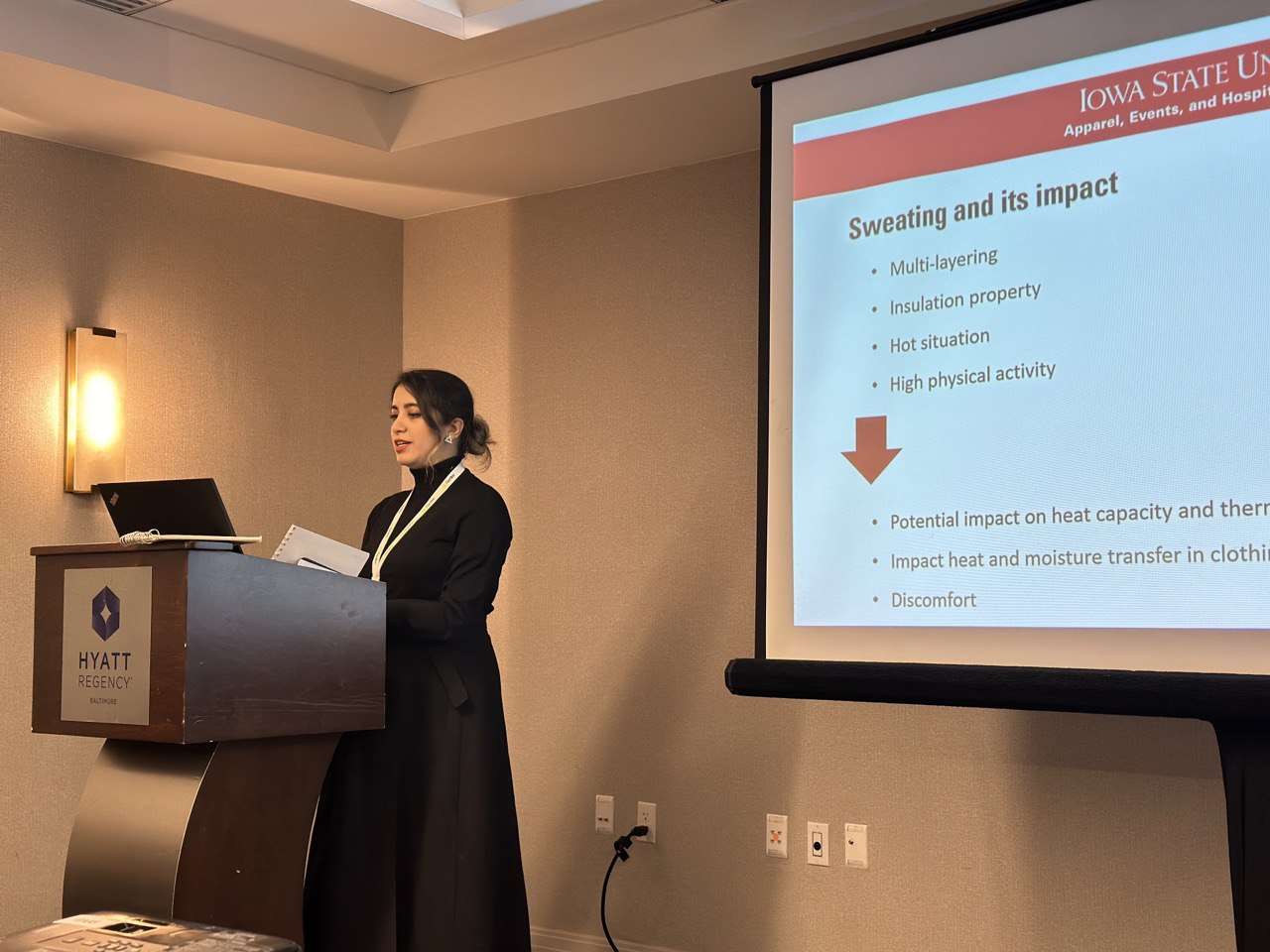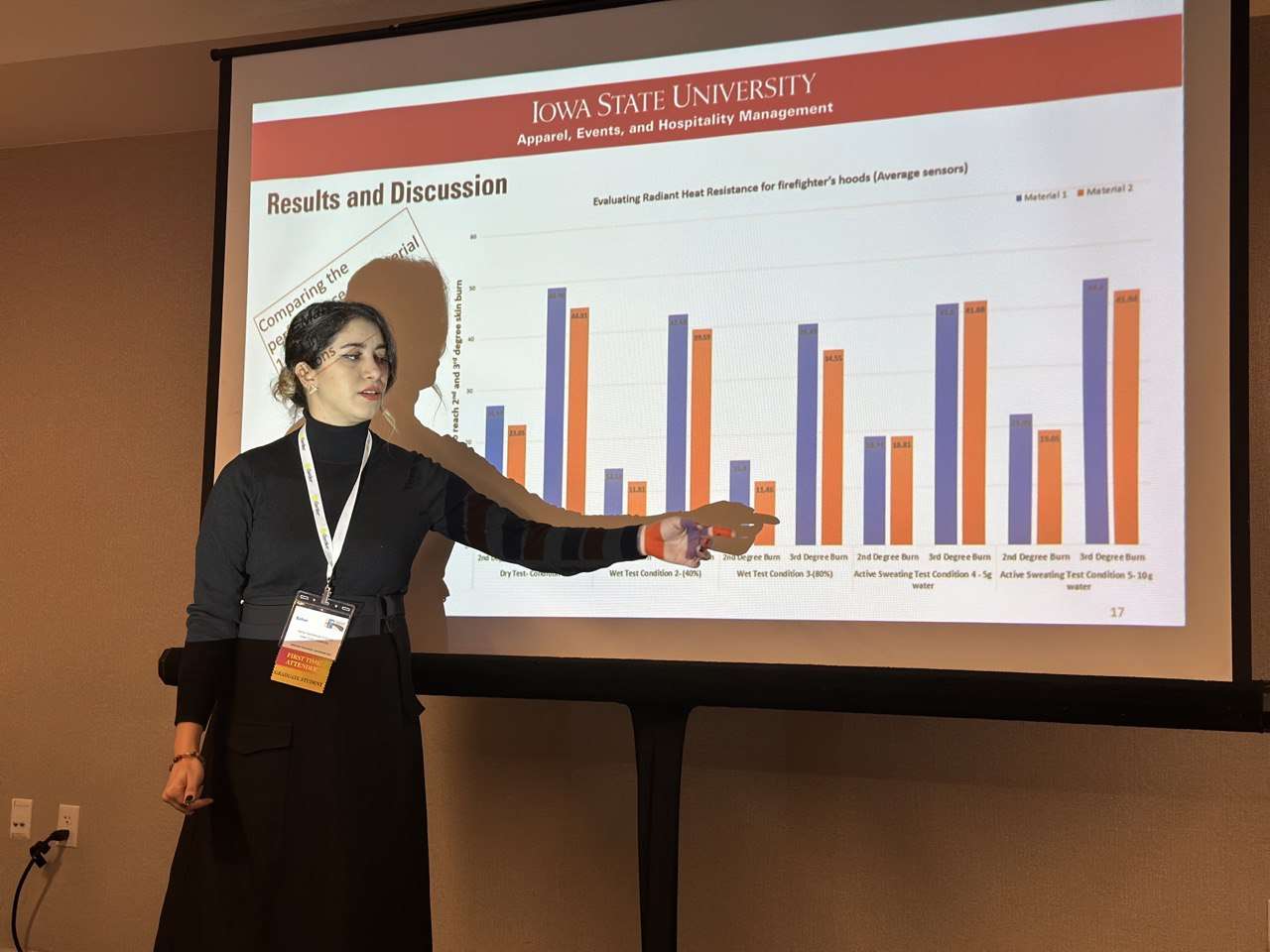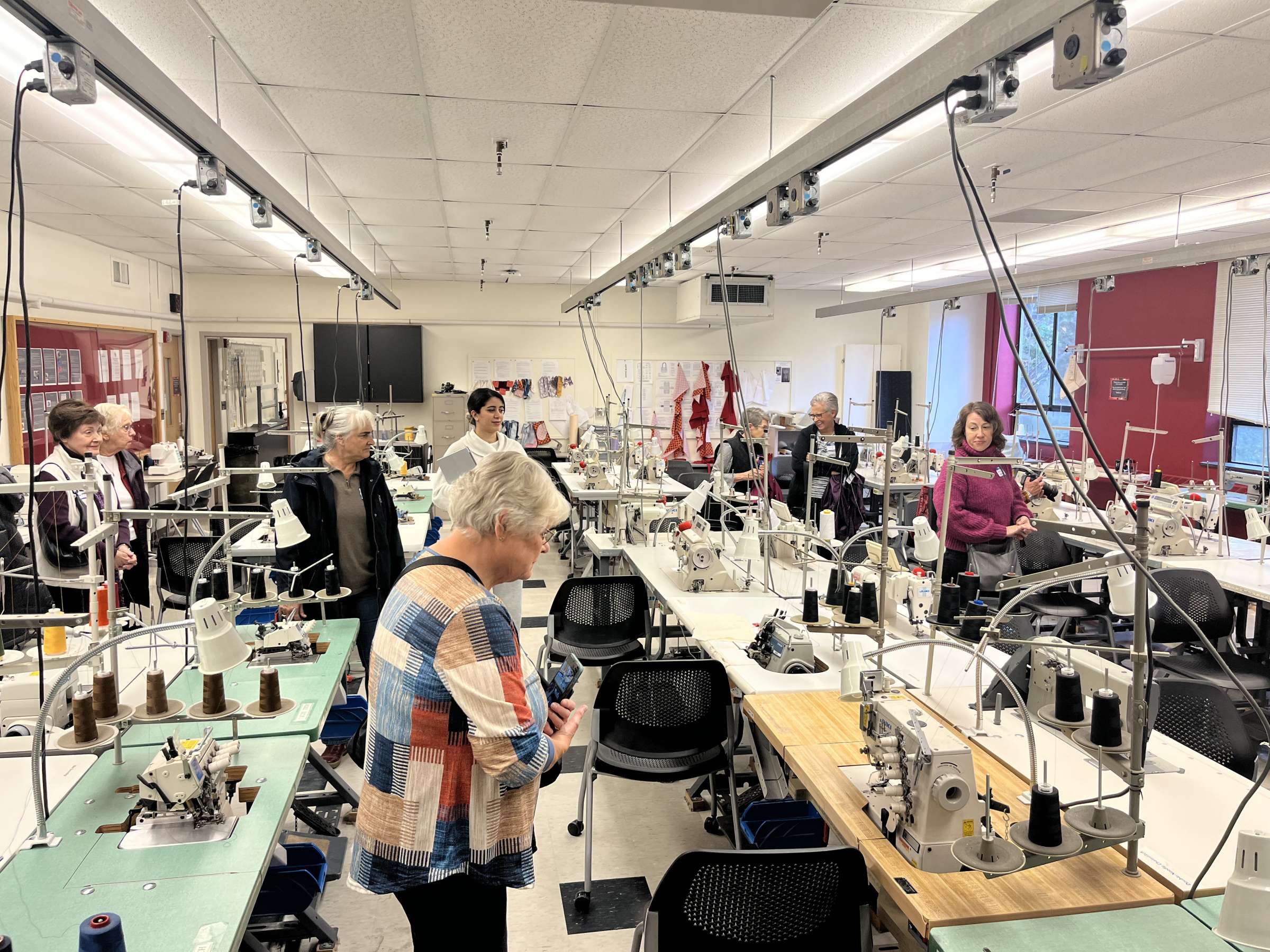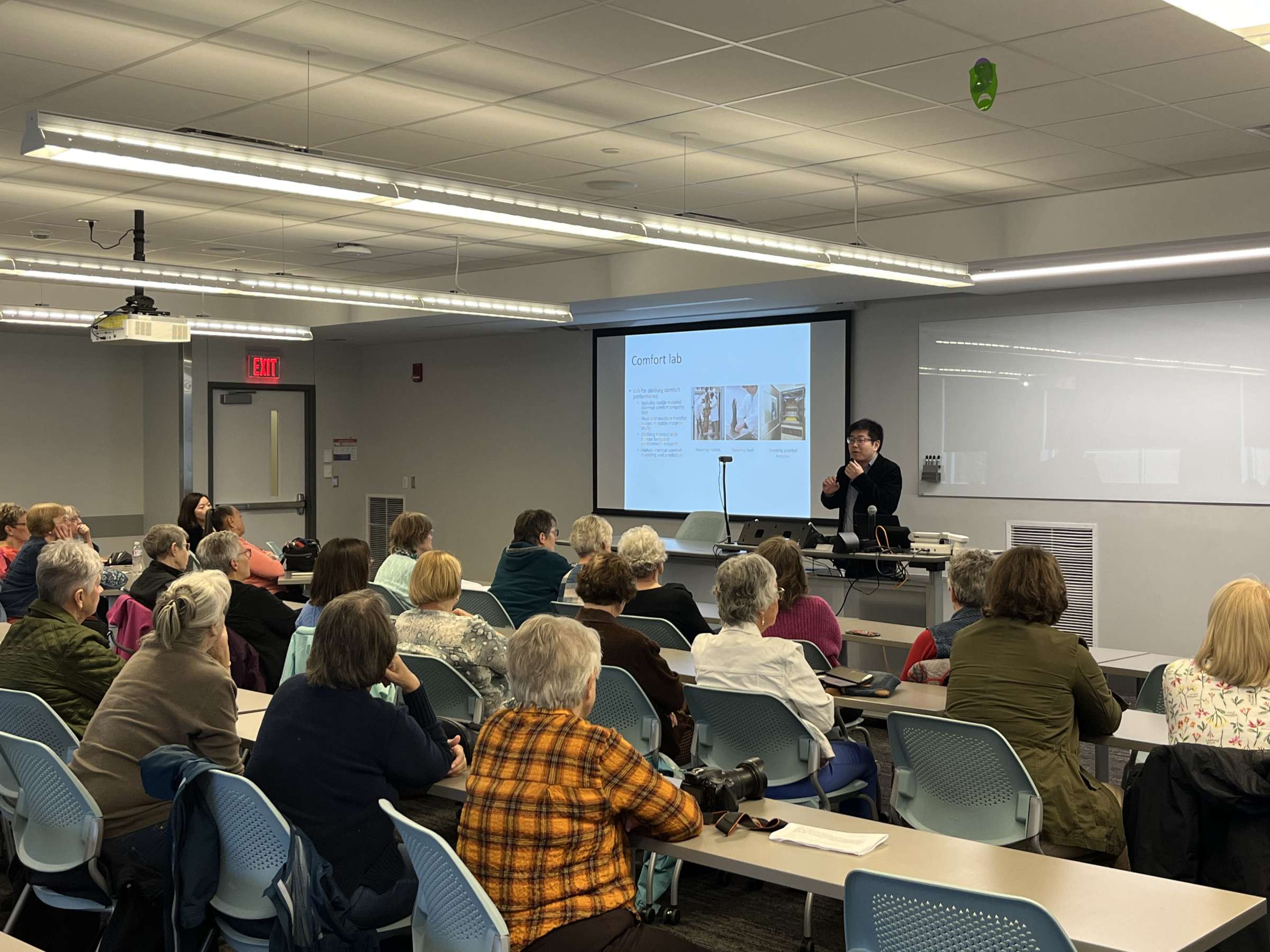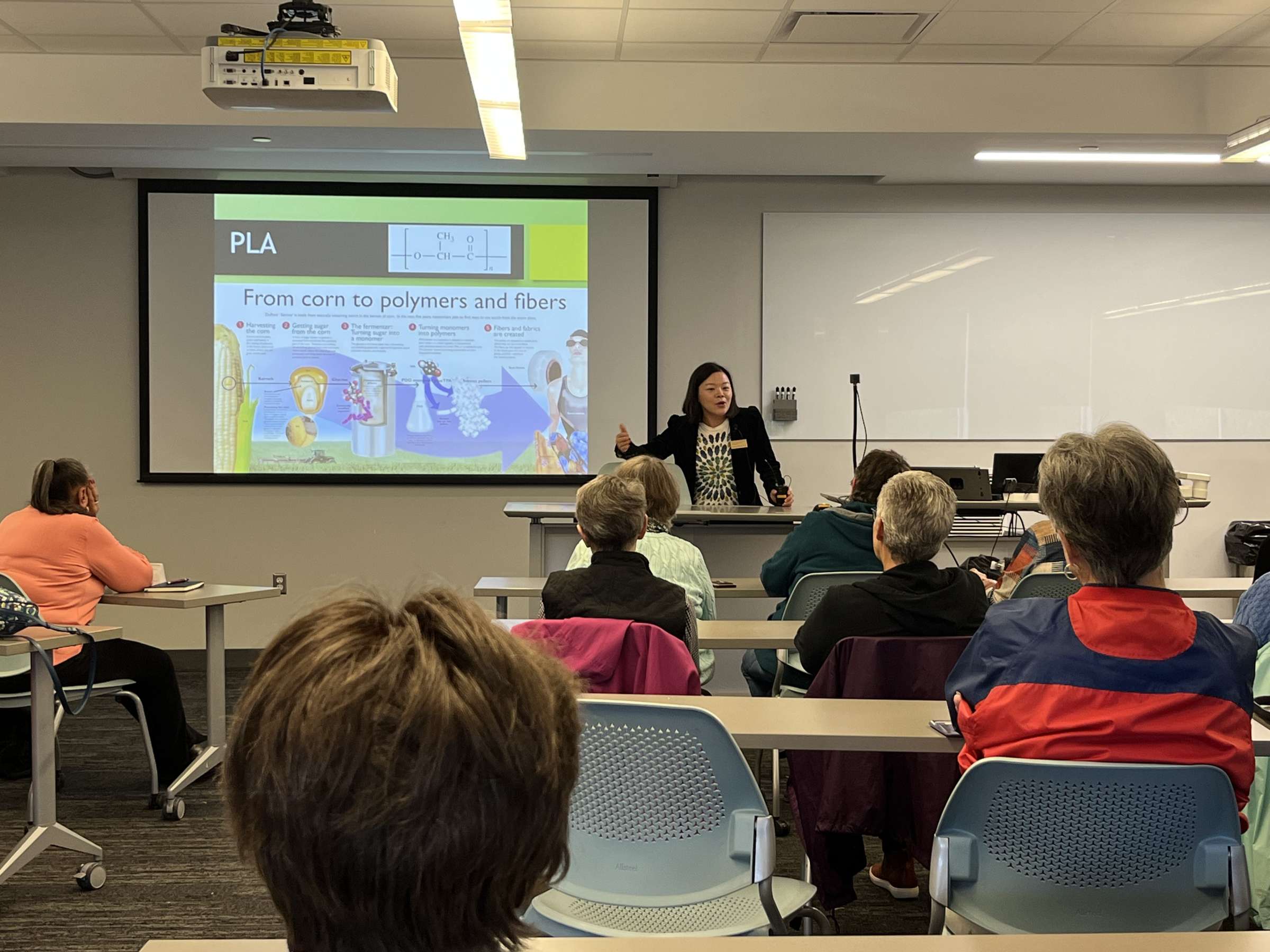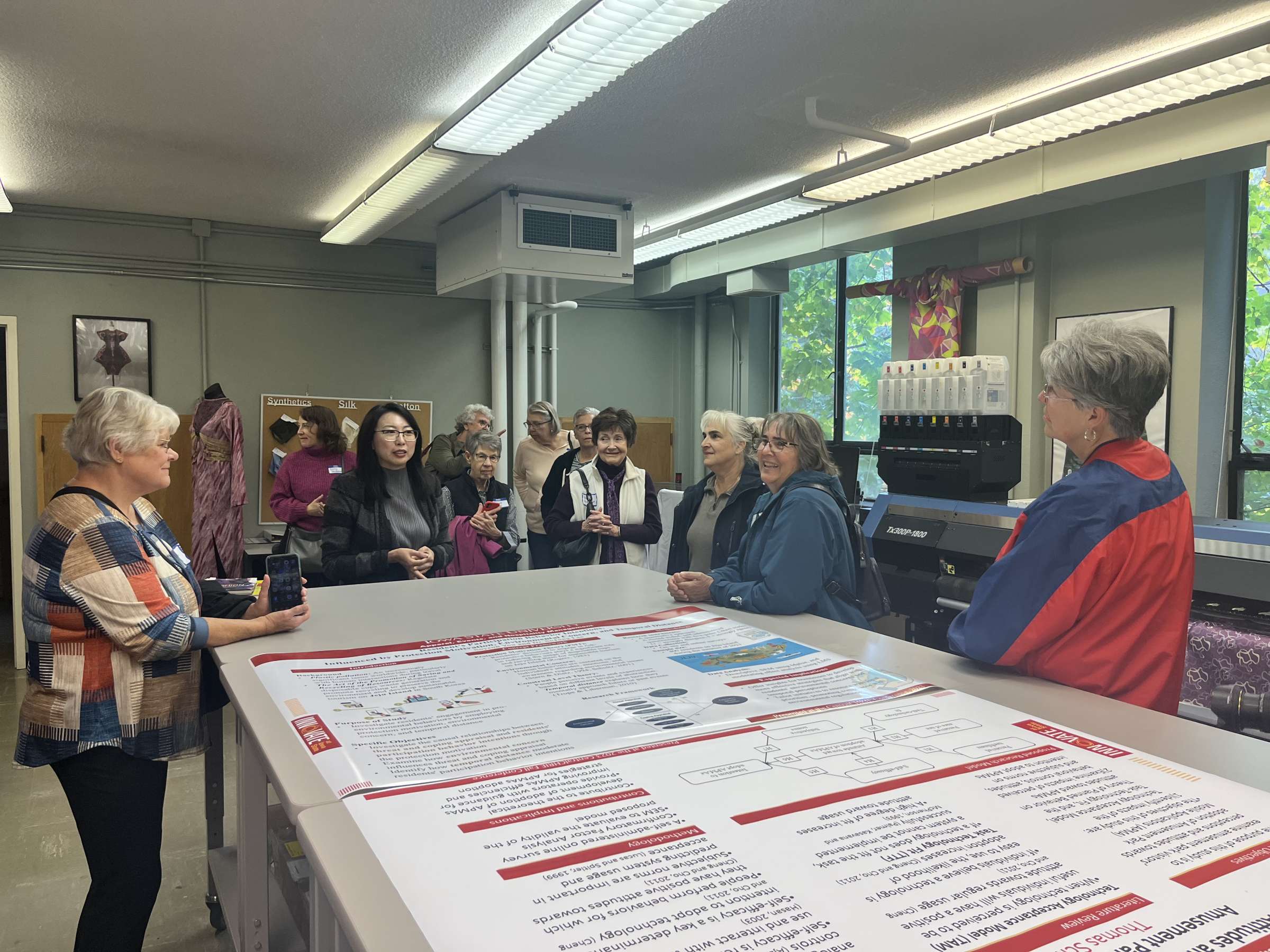
Firefighter Glove Sizing Study Wins Recognition at CoMFRE Poster Competition
Date: October 29 2025

Congratulations to Md. Jalal Uddin Rumi for earning 3rd Place in the 2025 CoMFRE Student Poster Competition.
His poster, “Emerging Risks of Smoke Particles and Their Carcinogenicity from Lithium-ion Battery (LIB) Fires),”authored by Md Jalal Uddin Rumi, Md. Jakir Hossain, Yulin Wu, Mazyar Etemadzadeh, Sai Guruprasad Jakkala, Mengying Zhang, Todd A. Kingston, Rui Li, and Guowen Song, presents an in-depth investigation into the toxic and carcinogenic components of smoke generated during LIB fire events.
The research identifies high concentrations of ultrafine particles, significant metal emissions observed through SEM-EDX analysis, and elevated polycyclic aromatic hydrocarbons (PAHs) that pose serious environmental and health risks. A key finding of the study is that certain metals can penetrate layers of firefighter personal protective equipment (PPE), indicating the possibility of secondary contamination even when protective gear is worn. These results underscore the growing public-health concerns surrounding LIB fires, especially for firefighters and other high-risk groups, and highlight the need for improved PPE design, better battery state-of-charge management, and stronger safety standards as lithium-ion technologies continue to expand. This achievement reflects the team’s meaningful contribution to advancing research in fire safety, environmental protection, and health risk mitigation.
Illinois Fire Service Institute - Fire Service Women of Illinois Training Event
Date: October 17-18, 2025
Thank you to the Illinois Fire Service Institute and the Fire Service Women of Illinois for giving us the time and space to share our research with them!
On October 17th and 18th, researchers from ISU's NexGenPPT (Dr. Mengying Zhang, Dr. Rui Li, Yulin Wu, Mehmet Sefer, Fan Zhou, and Leslee Weible) and the University of Minnesota's Human Dimensioning Lab (Kyurey Park and Juan Angulo) were able to interact with women firefighters and talk about the research being done at both universities as well as invite them to participate using our newly developed app (see our funded research AI-SAFEHAND for more details) and through having their hands scanned.
The 13th International Manikin & Modelling Meeting (I3M) & The Clothing and Textile Sciences Research Meeting
Date: October 15-16, 2025
The 13th International Manikin & Modelling Meeting (I3M) & The Clothing and Textile Sciences Research Meeting took place at North Carolina State University on October 15th and 16th. The event brought together researchers to share the latest advancements in thermal properties in clothing, apparel and PPE modeling, ergonomic considerations and practices, and methods for measuring fabric performance.
Dr. Guowen Song represented NexGenPPT at the conference, presenting both an oral presentation and a poster.
The presentation, "Characterizing localized thermal insulation of gloves at the fingertip using a sensor integrated hand manikin and infrared thermography," was a collaborative effort by Dr. Mengying Zhang, Dr. Rui Li, Jie Yang, Fan Zhou, Yulin Wu and Dr. Guowen Song, and was featured during the Manikin Thermal Performance Studies session. In addition, the poster "Understanding Glove Manual Performance in Commercial Fishing: Insights from Simulated Wet Testing" authored by Leslee Weible, Dr. Mengying Zhang, Dr. Rui Li, and Dr. Guowen Song, highlighted the team's work developing PPE testing methods that simulate the commercial fishing work environment.
Innovative Research in a New Space: Showcasing NexGenPPT's Lastest Work
Date: October 14, 2025
Earlier this year, the NexGenPPT team welcomed members from the Iowa State University Foundation into our lab to show them research endeavors that our team are working on after being moved into our new space in the Human Nutritional Sciences Building. We were able to showcase our work for three of our research areas: 3D scanning for hand and glove dimensioning, smoke exposure testing for firefighter PPE contamination studies, and hand function performance testing. Throughout their visit, the ISU Foundation team worked to capture what our lab can do and what our lab strives for through some additional interviews with lab directors, Dr. Guowen Song and Dr. Rui Li.
Please enjoy the short video that they created for our research lab.
ISU Foundation filmed Cutting-Edge Research in Textiles Lab
Date: July 8, 2025

The NexGenPPT team welcomed Simone Stecker, Melanie Weibel, and Gabe Noll from the ISU Foundation to our lab to film and learn about three innovative research projects advancing protective technologies.
The filming session featured three key research areas:
3D Hand Scanning Technology
Dr. Mengying Zhang and Fan Zhou demonstrated their advanced photogrammetry system for creating precise digital hand models. The non-contact measurement approach provides accurate data for ergonomic design and protective equipment development.
Firefighter PPE Contamination Studies
Researchers Yulin Wu, Rumi Md Jalal Uddin, Mazyar Etemadzadeh, and Jakir MD Hossain showcased their smoke exposure testing practices. The system standardized smoke creation to help systematically evaluate how protective gear absorbs toxic chemicals during firefighting operations, with applications for improving decontamination protocols.
Hand Function Performance Testing
Leslee Weible's work examined how glove design impacts manual dexterity in hazardous environments. The research aims to optimize protective gear without compromising functionality.
Lab directors, Dr. Guowen Song and Dr. Rui Li, participated in interviews about the lab's research vision and impact.
The footage will highlight the lab's interdisciplinary approach to solving real-world safety challenges through advanced textiles research. Current projects focus on developing better protective equipment for firefighters, industrial workers, and other professionals facing occupational hazards.
Celebrating a Successful PhD Defense
Date: June 20, 2025
We are thrilled to congratulate Dr. Saloni Purandare on successfully defending her dissertation, "Development and Characterization of Novel Antimicrobial Nanomembranes Using ε-Poly-L-Lysine and Polyamide-6 for Medical and Protective Textiles," in June 2025.
Dr. Purandare’s groundbreaking research advances the field of functional textiles by developing innovative antimicrobial nanomembranes with potential applications in medical and protective gear. Her work addresses critical challenges in material science, combining the biocompatibility of polyamide-6 with the antimicrobial properties of ε-poly-L-lysine to create safer, more effective textiles.

Research Spotlight: Hand Measurement Through 3D Scanning and AI
Date: June 18, 2025
Our research team—Haoran Wang, Fan Zhou, and Mengying Zhang—is developing an innovative approach to hand measurement by combining 3D scanning technology with artificial intelligence. Drawing from their diverse academic backgrounds and expertise, each member brings unique perspectives that prove indispensable to this innovative project.
This methodology compares multiple measurement techniques to improve accuracy and efficiency in dimensional analysis. Early results demonstrate promising capabilities in predicting key anatomical landmarks through machine learning algorithms. The integration of 3D scanning and AI showcases how emerging technologies can work together to advance anthropometric analysis.
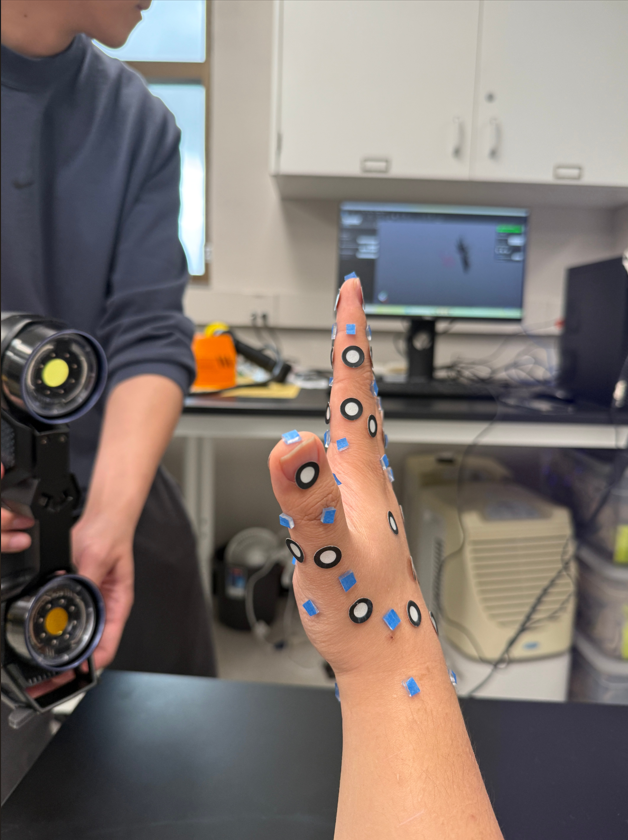
Graduate Research and Innovation Showcase
Date: April 24, 2025
Three graduate researchers from our program showcased their work at this year's Graduate Research and Innovation Showcase at Iowa State University's Student Innovation Center.
Mazyar Etemadzadeh and Md Jakir Hossain presented their poster "Biocatalytic Solutions for Safer Gear: Enzymatic Strategies for Decontaminating Firefighter PPE from Carcinogenic PAHs", examining firefighter PPE contamination and decontamination methods following smoke exposure.
Meanwhile, Leslee Weible shared findings from her digital poster “Understanding Manual Performance of Fishing Gloves in Wet and Dry Conditions: A Pilot Study”, investigating the performance of fishing gloves in various conditions, completed in collaboration with Dr. Mengying Zhang, Dr. Rui Li, and Dr. Guowen Song.
Graduate and Professional Student Senate Research Award
Date: April, 2025
Bahar Hashemian Esfahani has been awarded the prestigious Graduate and Professional Student Senate (GPSS) Research Award for her work on improving firefighter hood designs. Mentored by Dr. Guowen Song and Dr. Rachel Eike, her research focuses on enhancing protection, comfort, and performance through user-centered design and material innovation, addressing critical safety challenges in high-risk environments.
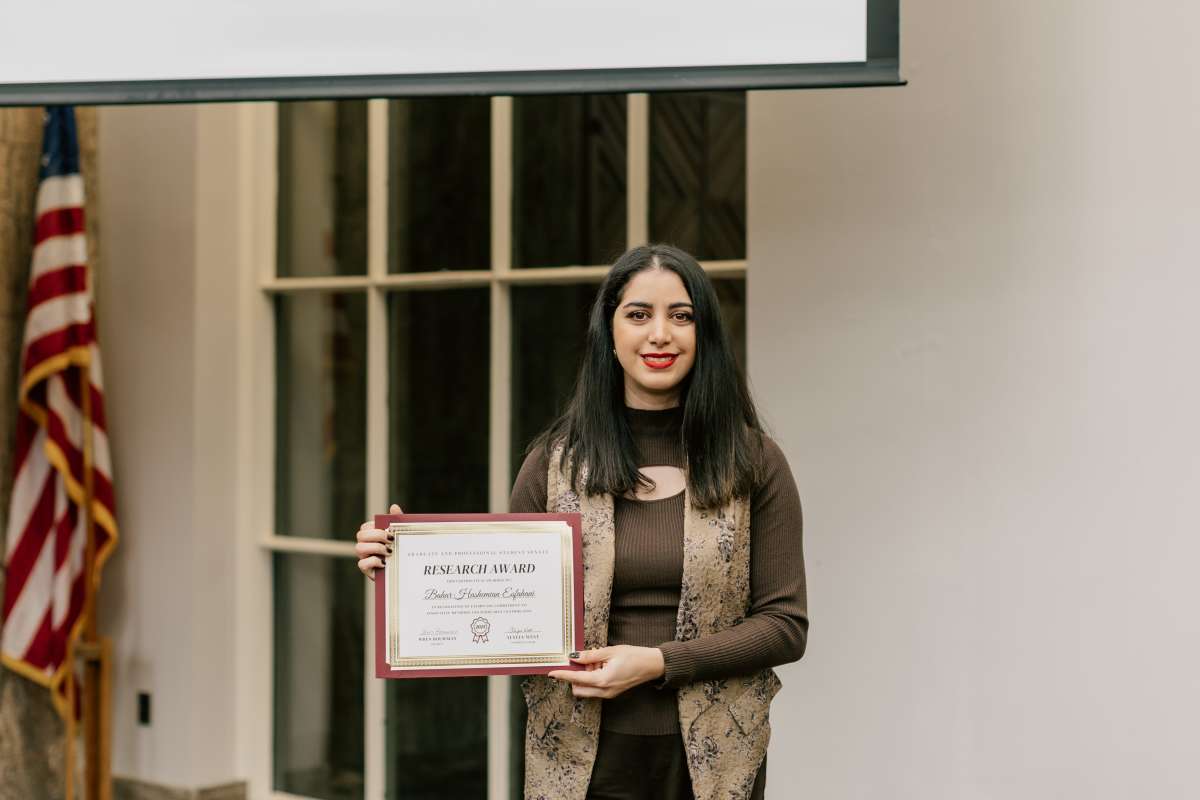
Award recipient Bahar Hashemian Esfahani
19th Annual Symposium on Undergraduate Research and Creative Expression
Date: April 17, 2025
Two standout Honors students, McKenzie Hitzel and Sophia McDonald, showcased their innovative research at Iowa State University’s 19th Annual Symposium on Undergraduate Research and Creative Expression on April 17, which celebrates groundbreaking work by undergraduates across disciplines.
Mentored by Leslee Weible, McKenzie investigated how the fit of commercial fishing gloves impacts wearers’ torque strength and comfort. Her research could lead to better-designed gloves, enhancing safety and performance for workers in demanding marine environments.
Guided by Saloni Purandare, Sophia explored how adding nanofibers to medical masks influences their functionality. Her work addresses critical questions in healthcare, potentially leading to improved filtration and comfort in protective gear.
FDIC International Conference 2025
Date: April 10 -12, 2025
FDIC International took place in Indianapolis, IN from April 10th to 12th, 2025. NexGenPPT members attended to exhibit the research being done and the needs of the firefighting community regarding AI-driven safety solutions.
The team, including Shuairan Chen, Dr. Rui Li, Fan Zhou, Leslee Weible, Mehmet Sefer, Haoran Wang, and Md Jalal Uddin Rumi, promoted and discussed the progress of the AI-SAFEHAND project. They engaged with conference attendees to gather insights on firefighters' experiences, challenges with current PPE, and perceptions of occupational dangers
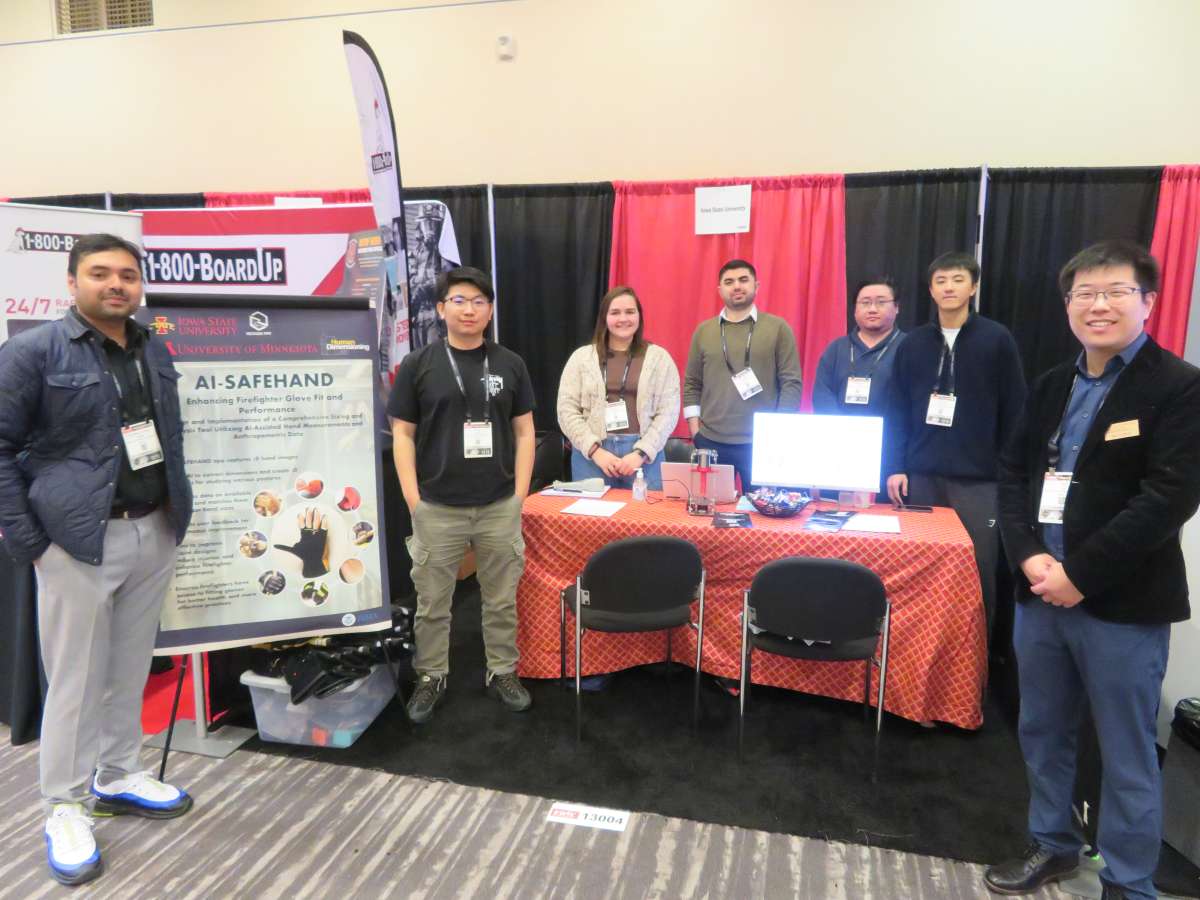
NexGenPPT Exhibition
Nanovax Conference 2025
Date: April 2-3, 2025
Md Jalal Uddin Rumi and Md Jakir Hossain attended Nanovax annual conference took place in Ames, IA, from April 2-3, 2025.
Md Jalal Uddin Rumi presented at the poster sessions with the poster "The Invisible Risk of Ultrafine Particles from Wildland-Urban Interface Fires: A Growing Challenge and Hidden Threat for Humanity".
Md Jakir Hossain also presented the poster "Decoding Firefighter PPE Contamination: Characterization and Decontamination Insights from Lab-Simulated Smoke Exposure"
Fire Industry Education Resource Organization 2025
Date: March 9 -12, 2025
The Fire Industry Education Resource Organization (FIERO) held its annual meeting in Greenville, SC. Dr. Rui Li and Mengying Zhang traveled to the meeting to learn more about the research and concerns being faced by the firefighting community.
The team showcased five research posters highlighting advancements in fire smoke and protective equipment. For fire smoke research, three posters by Md Jalal Uddin Rumi, Yulin Wu, Mazyar Etemadzadeh, Md Jakir Hosain, Mengying Zhang, Dr. Rui Li and Dr. Guowen Song were presented:
- Unveiling Fire Emission Profiles: Comparative Analysis of Wildfire, Structural Fire, and Battery-Related Fire Using A Controlled Consistent Exposure Simulation System (ACCESS)
- The Invisible Risk of Ultrafine Particles from Wildland-Urban Interface Fires: A Growing Challenge and Hidden Threat for Humanity
- Decoding Firefighter PPE Contamination: Characterization and Decontamination Insights from Lab-Simulated Smoke Exposure
For personal protective equipment research, two posters by Bahar Hashemian Esfahani, Mengying Zhang, Fan Zhou, Jiaxin Shi, Dr. Rui Li and Dr. Guowen Song were displayed:
- Getting Ahead of the Hazard: Conceptualizing Future Firefighter Hoods Designs
- Optimizing Firefighter Glove Fit: Insights from Hand Dimensions and Glove Size Variability
Dr. Rui Li and Mengying Zhang also presented the research updates and direction on AI-SAFEHAND and Smoke systems, as well as studies on silicone wristbands for hazard monitoring and particulate-blocking hood designs.

Dr. Rui Li presenting "Harnessing the Power of Silicone Wristbands: From Passive Data to Active Firefighter Safety"
International Fire Cancer Symposium 2025
Date: February 10-12, 2025
The International Fire Cancer Symposium was hosted at the University of Miami in Miami, FL where researchers and fire service members attended to learn more about current research through presentations and a poster session. Dr. Rui Li, Mengying Zhang, and Leslee Weible attended to present two posters for NexGenPPT regarding the smoke characterization project that is ongoing and expanding within the lab. During the awards portion of the last day, Dr. Rui Li accepted the 2nd place award for the merit of the research presented within “Decoding firefighter PPE Contamination: Characterization and Decontamination Insights from Lab-Simulated Smoke Exposure” and “Unveiling Fire Emission Profiles: A Controlled Comparative Study of Wildfires, Structural, and Battery-Involved Fires”. The research was done and posters were created by Mazyar Etemadzadeh, Md Jakir Hossain, Yulin Wu, Md Jalal Uddin Rumi, Dr. Rui Li, Mengying Zhang, and Dr. Guowen Song.
100th Annual Iowa Fire School
Date: January 25-26, 2025
The NexGenPPT team attended the 100th Annual Iowa Fire School in Altoona, IA to promote their research on smoke emission, glove sizing and hand function testing. Graduate students (Shuairan Chen, Fan Zhou, Leslee Weible and Md Jakir Hossain) and post-doc student (Mengying Zhang) discussed their current work with firefighters between their sessions as well as working to understand their perspective on issues like lithium-ion battery fire smoke and the fit of their personal protective equipment. Dr. Rui Li also had the opportunity to host two sessions over the course of the fire school that focused on the research that NexGenPPT and its students have done on the dangers of smoke emissions and decontamination.
Date: December 17, 2024
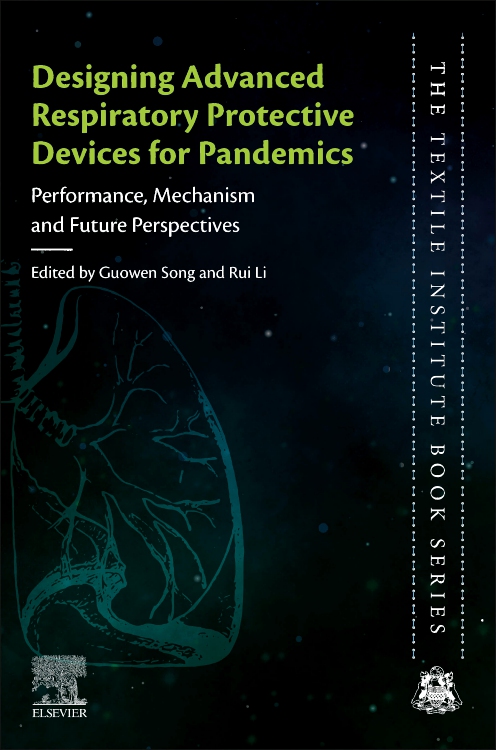
NexGenPPT leaders, Dr. Guowen Song and Dr. Rui Li, edited Designing Advanced Respiratory Protective Devices for Pandemics: Performance, Mechanism and Future Perspectives, which has now been published! Other members of our team were featured within the publication including Mengying Zhang and Yulin Wu.
Designing Advanced Respiratory Protective Devices for Pandemics: Performance, Mechanism and Future Perspectives identifies emerging and critical issues that directly or indirectly influence the protective performance of Respiratory Protective Devices (RPDs), along with important future research directions. The severity of the COVID-19 pandemic emphasizes the vital role of respiratory protection provided by PPE (and RPD) in novel infectious respiratory disease control. A wealth of recent research on coronavirus mitigation measures is combined with prior information on infectious diseases, RPDs, and human physiological and psychological responses to make this a fundamental resource on recent advances, innovative perspectives on respiratory protection, and new applications.
The effectiveness of such disease control measures rely greatly on the performance of the RPD, user compliance, and proper use. Only an interdisciplinary approach to this issue can lead to success.
Graduate College Research Excellence Award
Date: December 2024
Congratulations to Yulin Wu!
Yulin, a doctoral candidate and member of the NexGenPPT team, was awarded the Graduate College Research Excellence Award in December 2024.

ITAA 2024 - Presentations and Awards
Date: November 20-23, 2024
Presentations
The International Textile and Apparel Association (ITAA) annual conference took place in Long Beach, CA from November 20-23, 2024. NexGenPPT was proudly represented during the proceedings through presentations and posters, showcasing the outstanding research that is taking place.
Bahar Hashemian Esfahani and Leslee Weible presented at the poster sessions that were held during the ITAA conference, showcasing work done regarding firefighter hoods and commercial fishing gloves respectively.
Md Jakir Hossain and Mazyar Etemadzadeh presented in a new category this year, the Pecha Kucha. Their presentation illustrated the work being done and future direction for firefighter gear decontamination.
Awards
Congratulations to Ha Eun Chae, who was awarded the Sara Douglas Fellowship for Professional Promise at the 2024 ITAA conference!
Ha Eun Chae presented one poster and two oral presentations at ITAA's annual 2024 conference before she received her award on that Saturday. Her presentations highlighted the work that she has done regarding healthcare worker PPE, specifically isolation gowns.
1st Place at 2024 CoMFRE Conference
Date: October 21-22, 2024
Congratulations to Mazyar Etemadzadeh and Md Jakir Hossain, PhD students and members of the NexGenPPT team, who are the 1st place winners for the student poster contest at this year's CoMFRE (Center of Multiphase Flow Research and Education) conference and meeting, held on October 21st and 22nd. Their project, titled "Soot Characterization and Decontamination Challenges in Firefighter Gear," showcased the extent of soot penetration in current firefighter gear and compared various decontamination methods using SEM for enhanced visual assessment.
This year, the CoMFRE event featured 18 student posters, evaluated by three guest judges who engaged with each presenter to review their research. We extend our sincere congratulations to Mazyar and Jakir for their outstanding achievement and the hard work they put into this project, along with team members Yulin Wu and Dr. Rui Li.
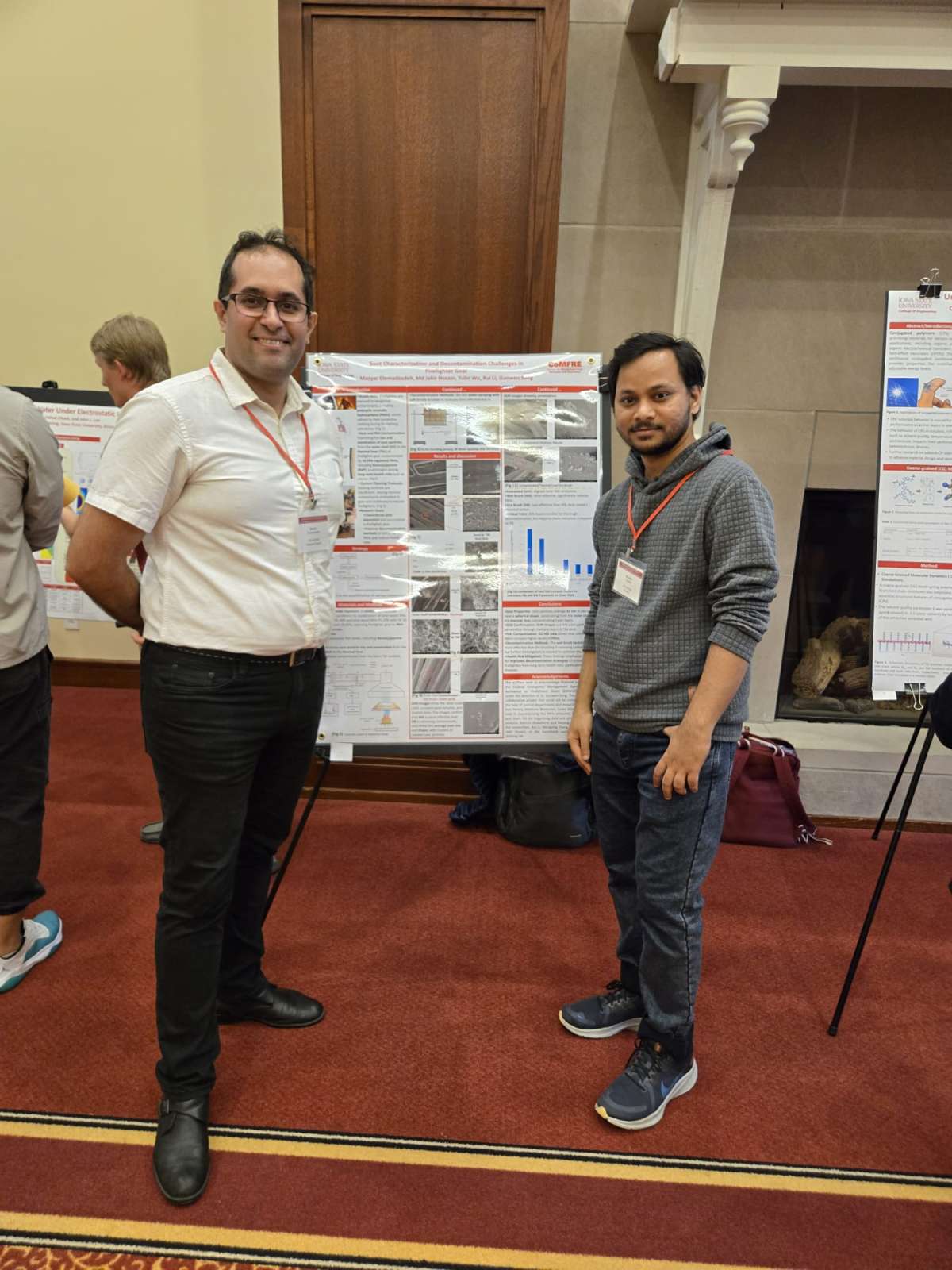
U.S. Fire Administrator Summit - R&D
Date: October 6-8, 2024
FEMA grants are a resource that helps support research that can lead to improvements to the health and safety of members of the fire service with areas of interest spanning topics like sleep, hydration, and personal protective equipment fit and function. Dr. Guowen Song, Dr. Rui Li, and PhD student Leslee Weible attended the U.S. Fire Administrator (USFA) Summit Research and Development session to present the progress and current results of the smoke contamination and AI-SAFEHAND projects. Recognition was also given to new grant recipients, including Dr. Song for "Guarding Against Lithium-ion Hazards: Understanding and Mitigating PPE Contamination in Battery-Involved Fire Smoke." Throughout this conference, they were able to connect with colleagues to discuss future projects and make plans for collaboration, as well as get valuable feedback for their research. The USFA Summit provides an avenue for critique and shows the progress being made by the researchers being awarded these grants, giving validity and weight to the topics that are being investigated.
Research Represented at Order of the Knoll
Date: October 4, 2024
The Iowa State University Foundation held an event on October 4th for the Order of the Knoll, a donor group, to show them the impact that donors have on the different areas of the university. Student speakers from four different colleges were included in the program to give insight into the student experience. Leslee Weible, a member of NexGenPPT and AESHM PhD student, spoke as a representative of the College of Health and Human Sciences. She painted a picture of how the state-of-the-art equipment and innovative research drew her to Iowa State. The new facilities that are being created help support this research and show that Iowa State values her program of study. Weible was excited to share about the thermal manikins that are housed in their lab as well as the importance of the multidisciplinary approach that is utilized within NexGenPPT to evaluate and improve personal protective equipment in her area of focus, Alaskan Commercial Fishing gloves, and within the fire service community.
Grant Writing Workshop
Date: October 1, 2024
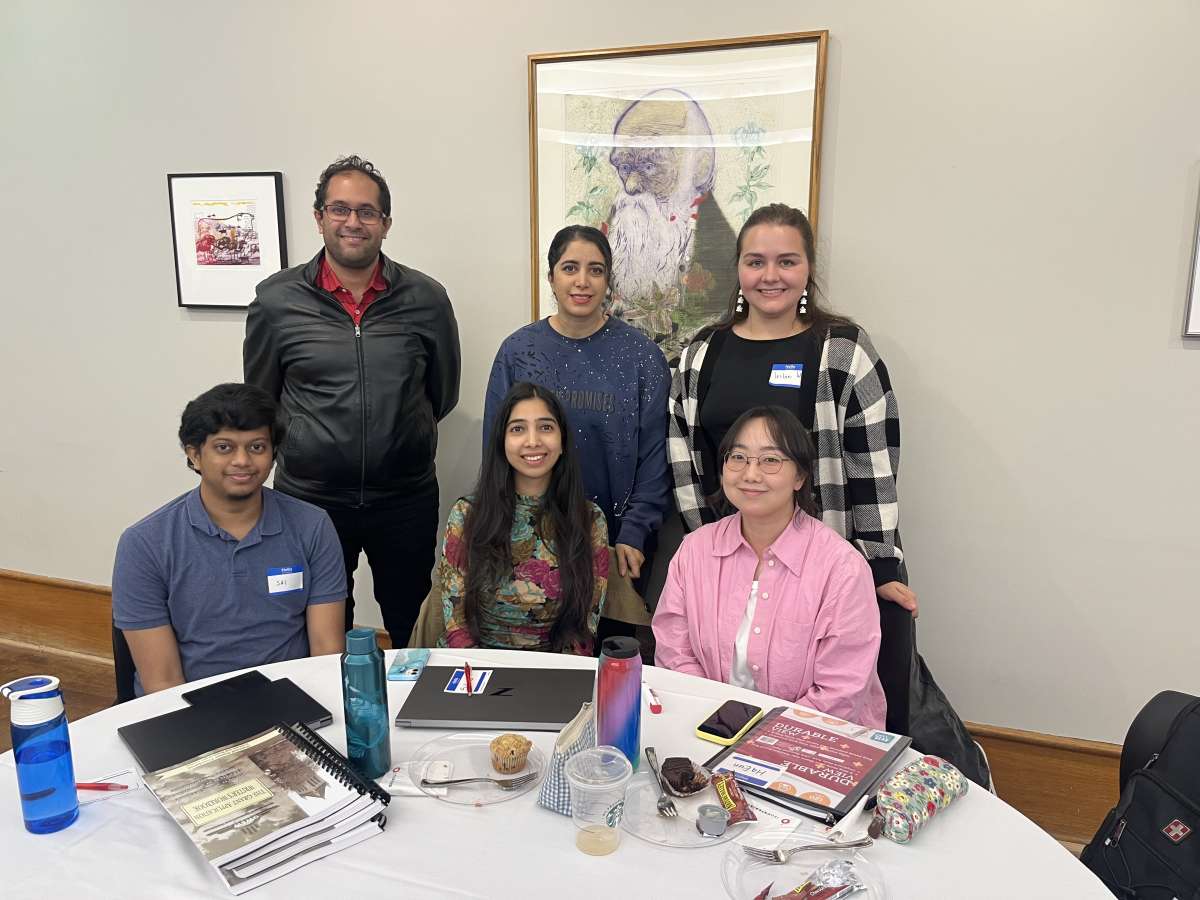
Grant writing is a skill that takes time and guidance to develop. On October 1st, Iowa State’s Office of the Vice President for Reach sponsored a workshop by Grant Writer’s Workshops and Seminars. Members of the NexGenPPT group (Postdoc: Sai Jakkala; PhD candidates: Saloni Purandare, Ha Eun Chae, and Bahar Hashemian Esfahani; PhD students: Mazyar Etemadzadeh and Leslee Weible) attended this workshop to expand their knowledge and understanding of how to structure and write grant proposals that are clear and creative. Dr. Robertson explained methods to effectively utilize your resources and write grant proposals that catch and hold attention. He made sure to also show the differences between the different funding agencies as knowing your audience and having common goals is half the battle in finding funding. This workshop helped to prepare our members to continue their research now and in the future through skills for securing funding and learning to write for an audience outside of their organization.
NexGenPPT has an Ion the Risks of Battery Smoke
Date: September 24, 2024
Recently, Dr. Guowen Song and his research team were awarded another FEMA grant to continue their work with smoke titled "Guarding Against Lithium-ion Hazards: Understanding and Mitigating PPE Contamination in Battery-Involved Fire Smoke." The team will be working with a growing issue in the world today by investigating battery-involved fire smoke. Lithium-ion battery-involved fires have become a more pressing danger as their presence in the world increases and changes the creation and composition of smoke. As the smoke changes, the way that it interacts with personal protective equipment (PPE) changes as well which inflates the danger faced by firefighters. The research team will work to understand the composition of smoke produced during battery-involved fires, what contamination of PPE looks like for these incidents and the effective methods for decontamination. Each step in this process is a step toward better protecting our fire service members and the community at large from the danger involved with lithium-ion battery-involved fire smoke.
Date: July 18, 2024
Saloni Purandare published a paper about the developing of an antimicrobial nanofiber by combining Polyamide-6 with ε-Poly-L-lysine, creating an advanced material for medical and protective textiles. Alongside Dr.Rui Li, Dr. Chunhui Xiang, and Dr. Guowen Song, Saloni presents a significant advancement in functional textile engineering with immediate practical applications. The innovative composite demonstrates remarkable properties, including instant super-hydrophilicity (0° water contact angle in 10 seconds), triple the tensile strength of standard Polyamide-6 (1.02 MPa vs 0.36 MPa), and long-lasting antimicrobial protection. This breakthrough, achieved through optimized electrospinning techniques, addresses critical limitations in current textile materials and opens new possibilities for safer, more functional medical gear and protective clothing.
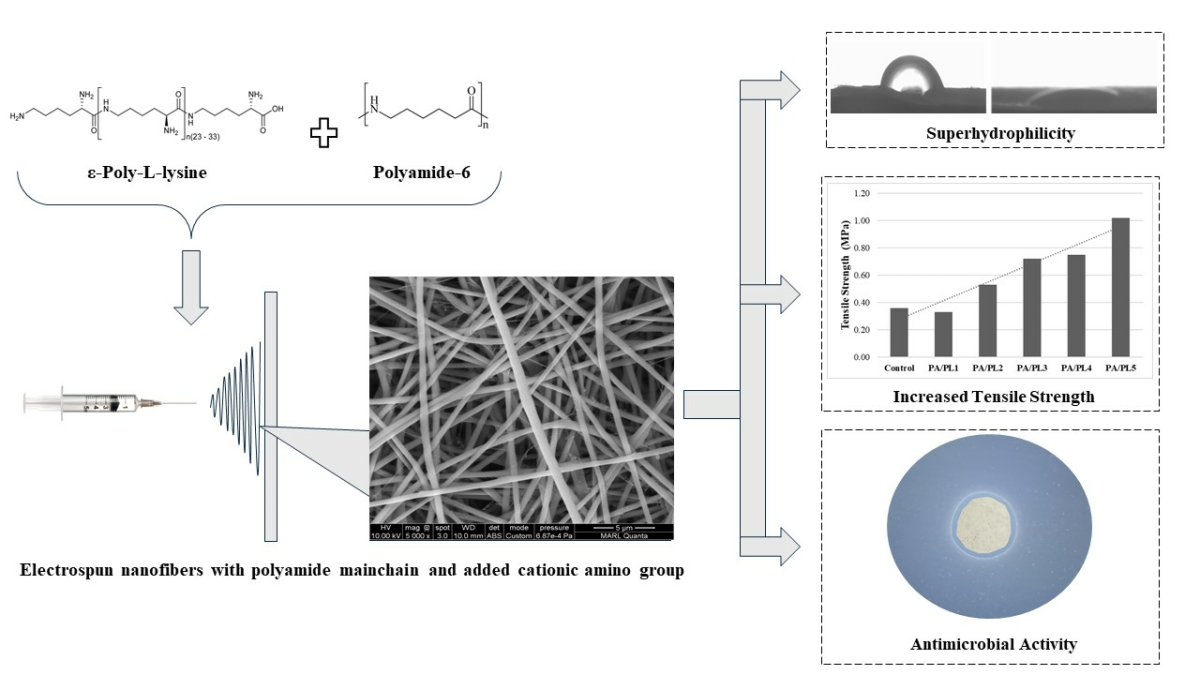
Next-Generation Textiles: Advancements in Functional Polymers for Sustainable, Smart and Health-Enhancing Fabrics
Date: May 31, 2024
The role of textiles in occupational safety and health is pivotal, especially in the domain of personal protective equipment (PPE). Across diverse fields such as healthcare, the oil and gas industry, extreme weather operations, firefighting, and military service, the demand for advanced textiles that can provide enhanced protection against specific occupational hazards is increasing. These hazards range from exposure to harmful particulates and toxic gases in firefighting to biological threats in healthcare settings, and extreme environmental conditions faced by military personnel. The effectiveness of PPE, including garments, gloves, and masks, depends significantly on the functional properties of the textiles used in their construction.
This Special Issue "Next-Generation Textiles: Advancements in Functional Polymers for Sustainable, Smart and Health-Enhancing Fabrics," invites researchers to contribute original research articles, reviews, and case studies on the latest developments in functional polymers for textiles. The focus is on innovative materials that offer smart solutions, such as self-decontaminating surfaces, temperature regulation, and improved mechanical durability, while also prioritizing sustainability and environmental friendliness. Contributions may explore the synthesis and application of novel polymeric materials in textiles, advancements in nanotechnology and biotechnology for textile enhancement, and the development of smart fabrics that respond to environmental stimuli with applications in occupational safety and health.
Summertime is Heating Up
Date: May 31, 2024

As summer weather starts to heat up and people are spending time out in the sun, the question of what to wear becomes prevalent. There are many factors to consider when looking for the perfect ensemble from fabric to fit to the accessories that you choose. Dr. Guowen Song gave his expertise on the subject, advocating for people to consider how their clothing choice will aid the evaporation process as it will help them stay cool. The TIME article further details the different avenues that a person can look at when dressing for the heat, including the need to consider every layer that is added even down to your undergarments. To read more of the article, click here.
Frontiers Research Topic: Challenges and Emerging Issues on Firefighter’s Toxic Chemical Exposure
Written by Karthika Suresh Kumar
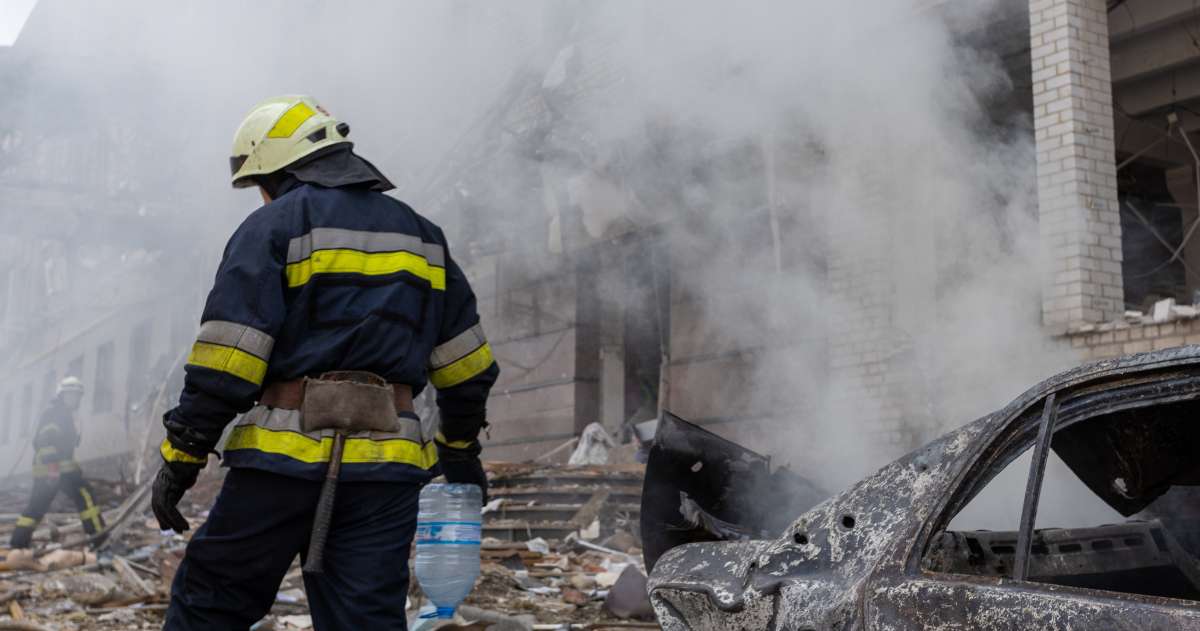
Research Focus: Firefighter Health and Hazard Mitigation
This study addresses critical aspects of firefighter health, focusing on:
-
Mechanisms: Investigating contamination mechanisms, effective decontamination, and prevention strategies.
-
Chemical Characterization: Examining smoke chemicals, including PFAS, and their impact on PPE contamination.
-
Decontamination Effectiveness: Assessing the effectiveness of decontamination protocols to minimize health risks.
-
PPE Interaction and Health Effects: Understanding how contaminants interact with PPE systems and their effects on firefighter safety and health.
-
New Technologies: Exploring innovative technologies for improved understanding and prevention of hazardous exposures.
-
Applications and Control Measures: Studying practical applications and control measures to safeguard firefighters from long-term health risks.
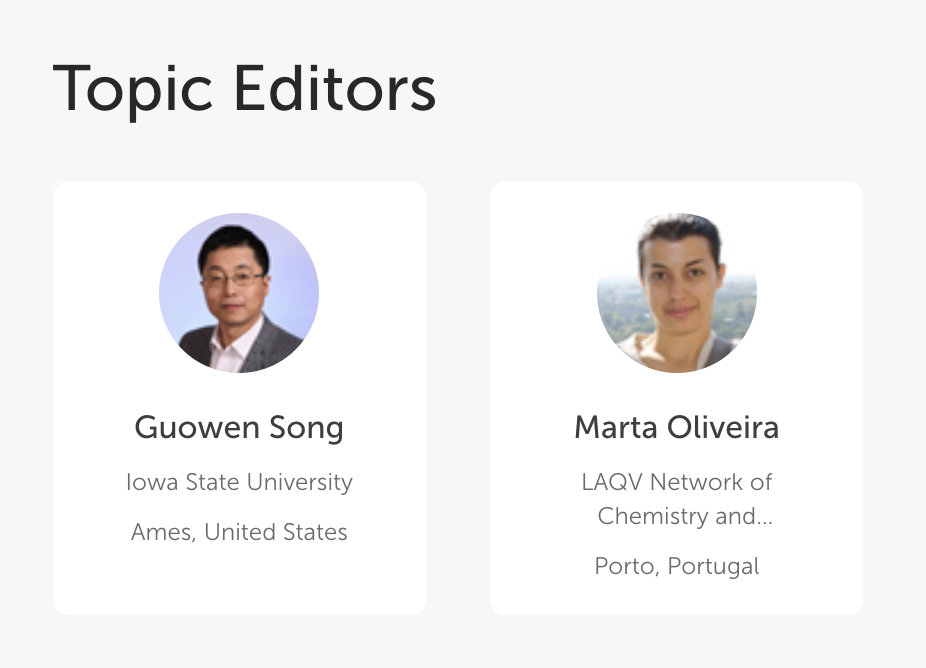
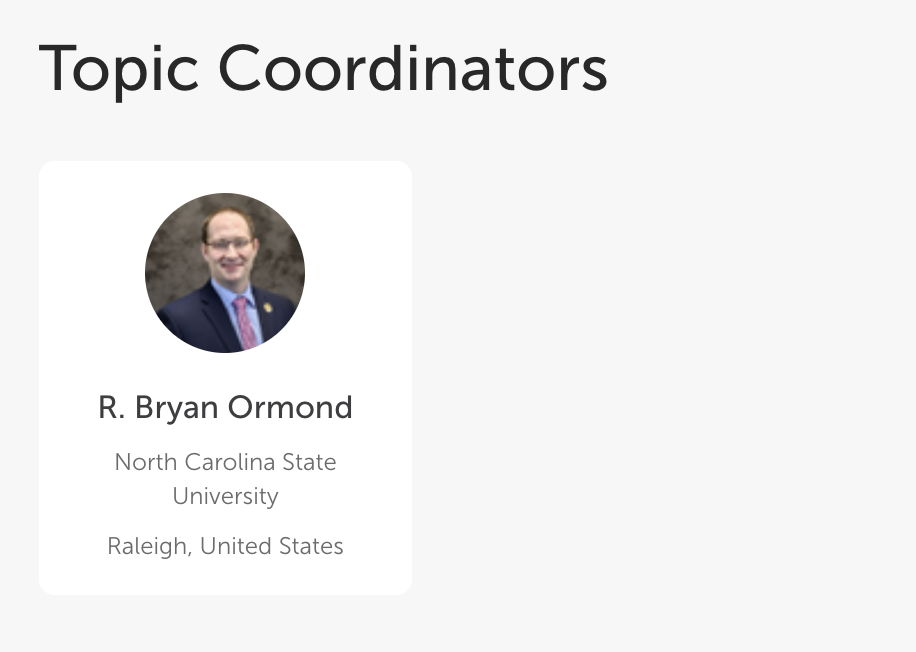
Date: May 16, 2024

In the tearoom, students avoid burning things — a stark contrast to the fiery experiments conducted in Guowen Song’s teaching and research labs. As the Noma Scott Lloyd Chair in Textiles and Clothing and professor in apparel, events, and hospitality management, Song oversees a team of researchers developing protective clothing primarily for health care workers and firefighters.
Song’s research has garnered national attention and millions in funding from federal agencies. Among other projects, he is leading a multi-university team of scientists developing next-generation personal protective equipment (PPE) for health care workers. The project is supported by a $1.8 million grant from the Centers for Disease Control.
Mazyar Etemadzadeh, a graduate student in apparel, events, and hospitality management, read about Song’s work and immediately “wanted to join his research group to improve PPE.”
Recent epidemics — COVID-19 and raging wildfires, specifically — have elevated pressing challenges in occupational health and safety. Song and his team are addressing such concerns, developing groundbreaking fabrics that better protect workers from harmful toxins. Imagine nurses wearing PPE that kills viruses on contact; or firefighters in uniforms that block exposure to toxins that put them at risk for cancer.
FDIC International 2024
Date: May 16, 2024
With over 35,000 attendees and 800 exhibitors, FDIC International is an expansive conference that focuses on firefighters and fire service. During this conference, the NexGenPPT team traveled to Indianapolis where they were able to collect data and talk to key stakeholders about our AI-SAFEHAND initiative. Photos and 3D scans of firefighters were taken by Dr. Rui Li, Yulin Wu, Fan Zhou, Badrinath Balasubramaniam, and Leslee Weible (ISU doctoral students) alongside Tse-Hsun Kuo (University of Minnesota master’s student) during the exhibition event. The data was collected utilizing the University of Minnesota’s handheld 3D scanner and a scanner developed by ISU’s High Dimensional Optical Sensing Laboratory (HDOSL) and operated by Badrinath Balasubramaniam. Interacting with firefighters and fire service organizations brings light to the impact that this research will have on the community and highlights the importance of continued work within this field.
Fire Industry Education Resource Organization (FIERO) 2024
Date: May 16, 2024
The NexGenPPT team traveled to the Fire Industry Education Resource Organization (FIERO) PPE Symposium from March 17-20th. This symposium focuses on educating the community about research and current fire service practices, bringing awareness to the hazards and advancements being made to mitigate them. The team was able to attend many of these sessions and learn more about the hazards and research endeavors that are prevalent in the fire service industry while finding resources to enhance our own work.
Dr. Rui Li, Dr. Guowen Song and Dr. Mengying Zhang, a postdoctoral researcher, presented AI-SAFEHAND Revolutionizing Gear Selection: An AI App for Gloves. Their presentation covered the challenges surrounding current firefighting gloves and the conference goers’ perception of the as well as ISU’s current grant funded project, an initiative creating an app that will use AI to take a photo and help the firefighter using the app to obtain the correct size and fit for their glove. NexGenPPT presented more of their research in another FIERO session, this time focusing on smoke production and its interactions with PPE. Dr. Rui Li and Dr. Guowen Song were joined by Yulin Wu, an ISU doctoral candidate, to present their findings around PPE contamination, decontamination, and the creation of consistent smoke for research. These presentations helped to inform and bolster attendees to seek further information and participate in research at the NexGenPPT booth. ISU Ph.D. students, Fan Zhou and Leslee Weible, and University of Minnesota Masters student, Tse-Hsun Kuo, utilized the exhibition time given at FIERO to collect hand images and 3D scans to help inform the development of the AI-SAFEHAND app.
Overall, FIERO provided vital insights into research within the industry and allowed for strong connections to be made that will further current and future research endeavors.
Written by Joseph A. Cole, Joel Hewett, M.S.
Date: January 17, 2024
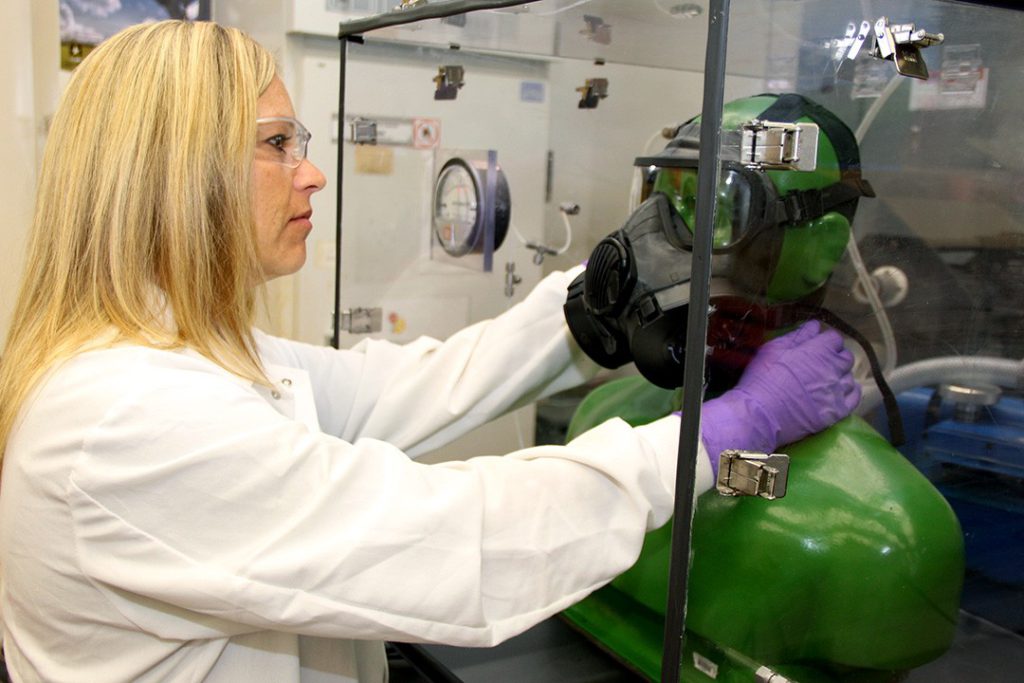
Over the past 20 years, the landscape of threats posed to U.S. forces by chemical and biological (CB) weapons agents has grown in both complexity and scope. While the CB protective overgarments currently issued to Warfighters are routinely improved upon and updated, they remain bulky, are cumbersome to wear, impose a high level of thermal strain on the wearer, and reflect decades-old technology. This state-of-the-art report surveys recent innovations made by government, military, academic, and commercial entities in producing the next generation of CB protective clothing, namely using a class of “functionalized materials” known as metal-organic frameworks. This report particularly outlines a line of innovation that has resulted in the testing of a CB protective ensemble that can be worn as a standard duty uniform, not a bulky overgarment, helping to unencumber the Warfighter from the added thermal strain and weight burden.
Building on NASA’s Storied History
Written by Janet Preus and Cathy Jones
Date: November 27, 2023

NASA has a long history of backing the research necessary to deliver fabrics that could withstand the extraordinary rigors of Space. Evelyne Orndoff is the Soft Goods Development and Testing Lead, Crew and Thermal Systems Division, for NASA. In her presentation at the Emerging Technologies Conference at ATA’s Expo, she discussed these historical fabrics, explaining how and why some are still in use, and some are not.
Faced with its current challenge—the South Pole of the Moon—the agency is looking for the next generation of history-making fabrics. About the Moon’s South Pole, Orndoff says, “This is the worst place to go. Nothing is round. [The regolith] is like glass, and it’s sharp down to the micron scale.” [...]
Research Presentation at the 2023 ITAA Conference
Written by Karthika Suresh Kumar
Date: November 9, 2023
Bahar Hashemian Esfahani, a third-year Ph.D. student in Apparel, Merchandising, and Design at Iowa State University, under the support and mentorship of Dr. Song and Dr. Rui Li, presented her groundbreaking research on "Evaluating Radiant Heat Resistance for Firefighters' Hood Materials" at the 2023 International Textile and Apparel Association (ITAA) conference in Baltimore, Maryland.
Bahar's research investigated the effects of sweating and moisture absorption on burn injuries in firefighter hood materials, employing a specially designed Sweat Simulation RPP tester. The results revealed that moisture content and active sweating reduced radiant heat protection compared to dry conditions. Increasing moisture content from 40% to 80% led to a significant rise in heat transfer in both materials, resulting in diminished protection. Surprisingly, increased active sweating from 5g to 10g resulted in decreased heat transfer and enhanced protection for firefighters. This research marks a significant step toward developing improved firefighter hoods, ensuring enhanced protection and comfort.
Congratulations to Bahar for her impactful presentation and dedication to advancing in-depth studies on improving firefighter hoods for enhanced comfort and protection!
Written by Karthika Suresh Kumar
AESHM warmly welcomed the Ames Quilt Guild and ISU Block Builders to Iowa State University on Friday, the 13th, offering an engaging and informative tour of our innovative work and dynamic workspaces. The day commenced with a presentation by Dr. Linda Niehm, providing insights into the department's remarkable growth. Subsequently, the group delved into the intricacies of current textile research led by Dr. Chunhui Xiang and Dr. Rui Li. A delightful meal in the Tea Room provided the perfect setting to digest the newfound knowledge.
Post-lunch activities included an extensive tour of three labs: the DATs Lab, Comfort Lab, and Hazards Lab. Participants witnessed the diverse array of tools and equipment available at AESHM, from industrial sewing machines for hands-on learning to hazard simulation capabilities and comfort-testing apparatuses like thermal manikins.
The tour culminated in two distinct experiences, with some members venturing to the renowned ISU Creamery while others concluded their visit at the Student Innovation Center. Here, attendees could explore the meticulously designed workshops and spaces tailored to foster student success in academic and personal endeavors. Notably, the visit showcased two student-run AESHM initiatives, the Sparks Café and Innovate 1858, serving as vibrant hubs for creative innovation and collaboration.
Seed Grant Awarded
June 20, 2023
Dr. Mengying Zhang, a postdoctoral fellow in the Department of Apparel, Events, and Hospitality Management, mentored by Dr. Guowen Song, has been awarded the 2023 Postdoctoral Seed Grant Award from Iowa State University. These grants provide postdoctoral scholars research funding in the role of a principal investigator while giving them an opportunity to develop independent research.
Dr. Zhang's research project focuses on developing an automatic hand anthropometric measurement tool using artificial intelligence (AI). This AI-based approach aims to improve the accuracy of hand measurements by reducing the potential for human error and decreasing the time and effort typically required for data collection. The tool will help compile detailed hand size data across various fields, supporting research that leads to better-fitting and more ergonomic gloves, tools, and equipment, enhancing occupational safety and work efficiency. The techniques developed could also be adapted for measuring other body parts, improving the overall fit and performance of personal protective equipment.
Congratulations to Dr. Zhang on her award and the promising work ahead.
Iowa Board of Regents Visit
Written by Billie Flaming
Last week our team hosted Board of Regents Member JC Risewick in a lab tour of our facilities. Every year, members of the Board of Regents meet with faculty to gain a better appreciation of the various roles faculty have at Iowa State University and establish connections with faculty. This also allowed the LABS to showcase the programs, research, and notable activities present at the university.
Regent Risewick was able to tour two different labs and have a conversation with Dr. Song and other team members about our work researching personal protective technology and equipment, as well as our plans for the future. The next generation of PPT is just ahead, and we're looking forward to sharing it and making the world a safer, more prepared place for workers across industries.
Internationally Distinguished Speaker
Written by Billie Flaming
The third International Conference on Functional Textiles and Clothing took place in New Delhi, India February 2023, and NexGenPPE's Dr. Guowen Song was honored as a distinguished speaker for the event. The only speaker based in either of the Americas, Dr. Song joins leaders from across the globe as they drive developments in the field of textile materials as well as the apparel production process, bringing the next generation of PPE ever closer to the present.
NexGenPPE at the FIERO Symposium
Written by Billie Flaming
Firefighters' capacity to do their job well is deeply related to their PPE and how safe they are when entering dangerous environments. The practices around contamination and decontamination and protective glove fit are the center of NexGenPPE's funded grants. Attending the FIERO 2023 Conference allowed our team to discuss and learn from fire service members directly about these issues.
The Fire Industry Education Resource Organization had many presenters, and our own Dr. Rui Li presented two different sessions to firefighters and members in the industry. He introduced the basis of NexGenPPE's research and plans for the future and our continued relationships with FEMA, NIOSH, and fire departments around the country. His presentations were well received, and the team was able to connect further with the conference attendees at the NexGenPPE exhibitor's booth.
The exhibitor's booth gave our team the chance to introduce our research and also father data. Bringing along our handheld 3D scanner, we were able to get three-dimensional scans of firefighter's hands, valuable pieces of data to have as our glove fit project moves forward. Postdoctoral researchers Mengying Zhang, and Fan Zhou and Ph.D. students Bahar Hashemian Esfahani, Farhad Aghasi, Karthika Suresh Kumar, and Yulin Wu, all attended the conference and took the time to connect with fire service members and gather high-quality hand scans.
The connections we made, and things we learned at the FIERO Symposium will have a strong impact as we move forward with our research and will keep the firefighters, the end users and beneficiaries of this research, as the foundation of why we continue to learn and better this field of study.
Startup Factory
The NexGenPPE team recently completed a semester of study and learning as a part of Startup Factory, graduating with the rest of Cohort XII. The team gained skills in business management and valuable insights they will carry forward in their continued research and collaborations with industry leaders and collaborators.
The NexGenPPE team is accepting proposals for their yearly seed grant of $10,000. The last recipient of the seed grant was Dr. Rachel Eike, whose work on smart socks was impressive and valuable for filling knowledge gaps in the PPE area. More than one proposal can be submitted.
The deadline is 5:00 pm on Tuesday, December 20, 2022.
Submit Now!
Our goal is to secure and improve the quality of life through research that promotes an understanding of disaster risk exposure, sensitivity to hazards created by extreme weather conditions, and the adaptive capacity of the PPE.
Know More...
NexGenPPE Takes Next Steps in Las Vegas
Written by Billie Flaming

This October, the NexGenPPE team attended the American Chemical Society's Western Regional meeting in Las Vegas, Nevada. Several team members presented at the conference and attended the various panels, growing their connections and understanding of this important pillar of science in the field of PPE.
Along with attending the conference, the team also visited ECMS, a Verified Independent Service Provider (ISP) who cleans, inspects, and repairs firefighter turn-out gear in accordance with NFPA 1851, the guiding standards that direct the care of firefighter's PPE. The team was given a tour of the facilities and was able to ask questions about the cleaning process as it currently works within the ECMS system. The lessons learned by our team are detailed below.
1. The fire departments are the ones who decide when to send contaminated PPE in for cleaning. As such, there are few similarities between different firehouses in the frequency of cleaning and repairs.
2. The moisture barrier is washed with the thermal liner to maintain the integrity of the garment's shape.
3. ECMS uses conventional wet cleaning to balance cost, efficiency, and personal training.
4. An experienced worker determines the specific cleaning program for each gear set according to their assessment of the PPE's contamination level.
5. There is a concern for the ECMS team about the working environment's exposure to chemicals, detergents, and harmful particles from the PPE.
6. PPE cleaning is a heavy-labor business relying on wet cleaning methods; new clean techniques such as ultra-sonication or liquid CO2 are not widely accepted due to the cost and time-consuming nature of the techniques.
7. Currently verification method from NFPA 1851 can support the cleaning efficiency for a limited representative level. It can also provide contaminant removal based on data. However, physical methods to prepare contaminated samples are limited by smoke-lacking simulation and the selection of representative chemicals.
8. ECMS passes the NFPA 1851 for inspection, cleaning, drying, and repair functions. They not only return clean PPE to different fire departments but also know about PPE maintenance and contamination to increase the understanding of danger within a smoky fire situation.
It was valuable for the NexGenPPE team to see first-hand the methods and challenges currently facing the people who live with the borders drawn by the NFPA 1851 standard. As our team looks to the future and next generations of standards, it is important to keep in mind the fire safety personnel who will be wearing the PPE and the safety of the professionals tasked with its cleaning and repair.
Frontiers Special Issue
September 2, 2022
Dr. Guowen Song is taking part as a key editor for an upcoming special collection for Frontiers in Materials, entitled “Challenges and Emerging Issues on Firefighter’s Toxic Chemical Exposure: Smoke Chemicals, Contaminated PPE, and Off-gassing”.
Toxic chemicals, either from fire ground combustion, contaminated PPE, or off-gassing from PPE material and chemical finishing, have become the leading concern for the long-term health of firefighters. Exposure to fine smoke particles and toxic chemicals released from fire scenes can result in cancer, cardiovascular disease, and other pathological diseases, and minimizing this exposure has become a health priority for the firefighter. Firefighters face exposure to smoke at fire grounds and contaminants in fire stations, vehicles, and even their homes because of resuspended fine particles or released volatile chemicals from contaminated PPE, and our work will not only investigate this but also work to develop PPE that does not have these hazards built into the protective gear.
If you want to learn more about the collection, you may do so here: https://www.frontiersin.org/research-topics/39016/
ISU Related
Seed Grant Awarded
June 21, 2022
Dr. Ankit Joshi, a member of NexGenPPE's multidisciplinary team, is the recipient of the 2022 Postdoctoral Seed Grant Award. Congratulations, Dr. Joshi!
The aim of Dr. Joshi's research project is to develop the 3D multi-segment hand posture thermoregulation (3D-MHPT) model. The developed 3D-MHPT model will provide innovative pathways for designing and development of Next Generation (NexGen) personal protective equipment (PPE). PPE, such as gloves play a critical role in protection against exposure to extreme and hazardous environments and health issues related to it. For this specific project, we are focused on hand protection because hands are extremely vulnerable to cold weather injuries (CWI) and hand-arm vibration syndrome (HAVS) due to the nature of their anatomical geometry, anthropometry, and thermal physiology. One of the key components of 3D-MHPT model development is validating it through lab experiments and human trials.
Best wishes to Dr. Joshi's project and innovative work.
PhD Candidate
December 14, 2021
Yulin Wu is a PhD candidate of Iowa State's AESHM department, with research interests focused on the characterization of combustion emissions as well as the development of a contamination simulator. His current experiments involve utilizing a cone calorimeter and sampling contaminants with chemical analysis techniques.
Yulin intends to develop his preliminary work on combustion emissions through a contamination simulator. This simulator will be very helpful in estimating the effects of different PPE designs and decontamination methods on measure of protective performance.
Congratulations, Yulin!
Iowa Public Radio Spotlight
November 25, 2021
Dr. Guowen Song leads a team to redesign personal protective equipment. He says the pandemic has shed light on the need for PPE to be more comfortable, reusable, and safer.

Grant for improving PPE for health care workers
November 3, 2021
The team, led by Guowen Song, a professor and the Noma Scott Lloyd Chair in Textiles and Clothing at Iowa State University, received a $1.8 million grant from the Centers for Disease Control and Prevention to support the work. Song says the COVID-19 pandemic has exposed weaknesses in current PPE systems, which is why the team will focus on developing biological self-decontaminating fabrics to protect against live pathogens.
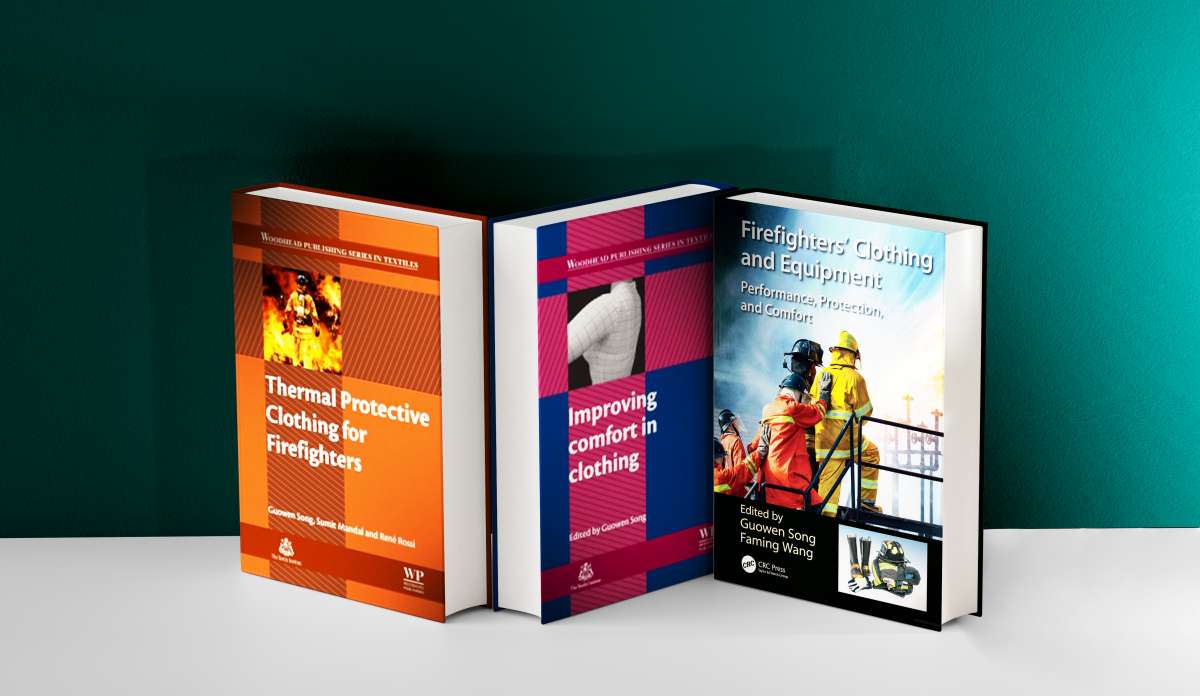
PPE Books Published
Our team was involved in the recent publications of three books, each covering a different aspect of PPE, including comfort, thermal protection, and the gear and equipment used to protect firefighters.
This collection shows the current state of PPE as well as tackling the knowledge gap facing this industry.
Industry Related
NFPA Research Foundation Seminar
February 17, 2022
Dr. Bryan Ormond and Dr. Arjunsing Girase from North Carolina State University presented a seminar on "Enhanced PPE Cleaning to Reduce Firefighter Exposure to Carcinogens"
Oct 30, 2018
Studies have shown that firefighter turnout gear and PPE that gets coated with toxic agents from the fireground can continue to transfer and off-gas contaminants long after the incident has ended. This article follows firefighter gear from contamination, through doffing, transport and cleaning to identify potential areas for exposure in the gear contamination cycle.
Mar 7, 2018
Potential NFPA revisions propose more frequent cleaning of any firefighter gear worn at an active fire


